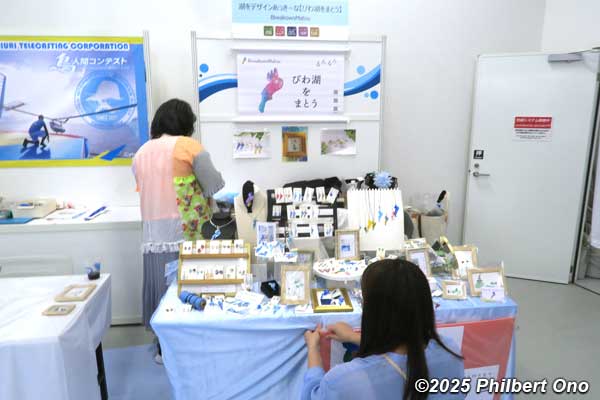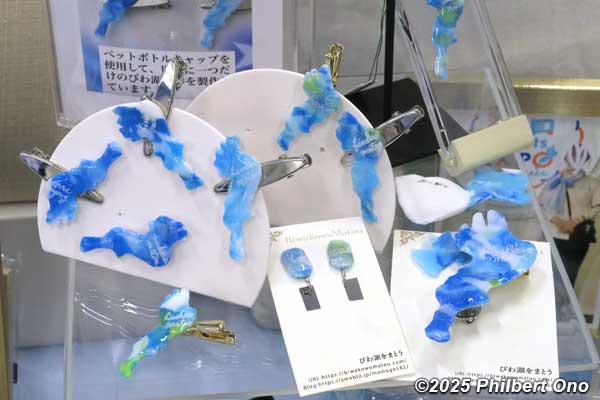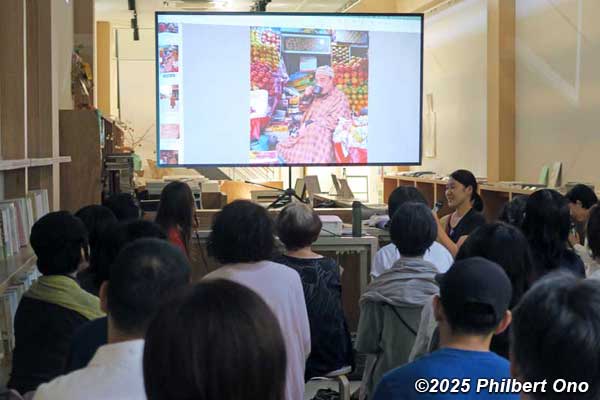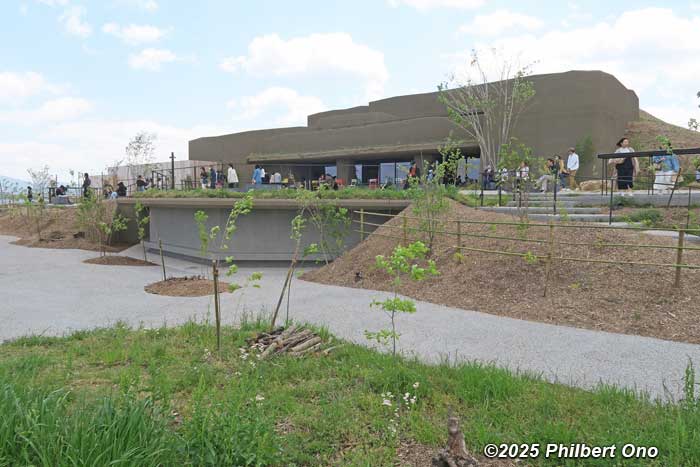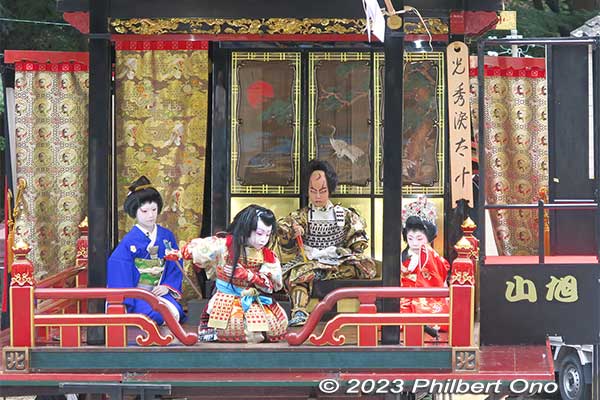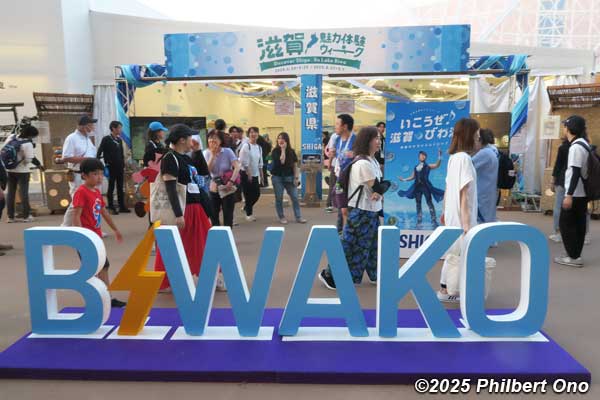
Updated: July 30, 2025
(大阪・関西万博で滋賀の発見)
Osaka-Kansai Expo 2025 (大阪・関西万博) just reached its halfway point on July 13. It’s been three months since it opened on April 13, and now only three months to go when it ends on October 13, 2025.
If you’re in Shiga or in Kansai and still haven’t seen the Expo, don’t miss it! See it at least once just to see what the fuss is about. It’s a historic world event, to be talked about for decades to come.
Shiga has a presence there too, in multiple ways and places as listed in this blog post. More to come from Shiga in the coming months at the expo.
If you live in Shiga and have any kids up to high school age, your child is eligible for free one-time admission. Just seeing and hearing the names of many different countries is educational for kids.
Osaka Expo 2025 is an official world exposition being held for six months in the city of Osaka in Osaka Prefecture, Japan. The expo site is on an artificial island in Osaka Bay named Yumeshima (夢洲) built with landfill (garbage).
Easy to get there by train/subway from Shin-Osaka or Osaka Station taking about 30 minutes to Yumeshima Station (Osaka Metro Chuo Line). From Shiga, it will take about 90 to 140 minutes depending on your nearest train station.
The last time a world exposition was held in Japan was 20 years ago at Expo 2005 in Aichi Prefecture. And the last time in Osaka was the beloved and grand Expo ’70 held 55 years ago. People still visit Expo ’70 Commemorative Park featuring the iconic Tower of the Sun sculpture by Okamoto Taro.
Contents
- Osaka Expo 2025 Overview
- Kansai Pavilion – Shiga Week
- Jellyfish Pavilion – Shigaraki ceramics
- Earth Mart – Omi-Hachiman reeds
- Future of Life – Ishiguro Hiroshi from Takashima
- Future Life Village – Shigaraki ceramics
- Zannen-ishi Toilet – Ohno Hiroshi from Omi-Hachiman
- Shiga-ken Day (Shining Hat)
- Birdman Rally Exhibition (Expo Exhibition Hall Wasse)
- Japan Annual International Art Festival (Expo Exhibition Hall Wasse)
- Austria Pavilion’s Austria-Shiga dish
- Official stores – Shiga merch
- Supplemental: Tower of the Sun – Shigaraki ceramics
- Osaka Expo 2025 Basic Info
Osaka Expo 2025 Overview
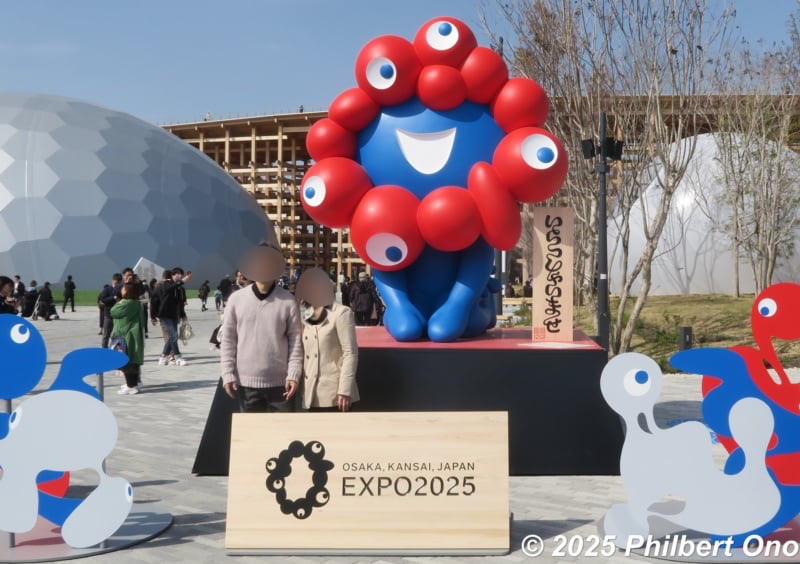
World expositions are a mass gathering and showcase of many countries, cultures, peoples, technologies, and ideas in line with the expo’s overall theme. On a site much larger than Universal Studios Japan, Expo 2025 has over 150 countries and regions with pavilions or booths along with over 20 Japanese pavilions.
The official name includes “Kansai” to also involve Osaka’s neighboring prefectures Shiga, Kyoto, Hyogo, Nara, Wakayama, Mie and even Tottori, Tokushima, and Fukui. Although these neighboring prefectures don’t have their own pavilions, they each (except Nara) have a booth in a shared building called Kansai Pavilion.
Although Expo 2025 pales in comparison with Expo ’70, it’s still a must-see especially for people in Kansai. Most Expo 2025 visitors actually come from Kansai, about 65 percent, and only 16 percent from Kanto Region (Tokyo) and 10.6 percent from Hokuriku Region, based on visitor counts up to June 20.
More Osaka Expo 2025 Basic Info below.
Kansai Pavilion – Shiga Week (滋賀魅力体験ウィーク)
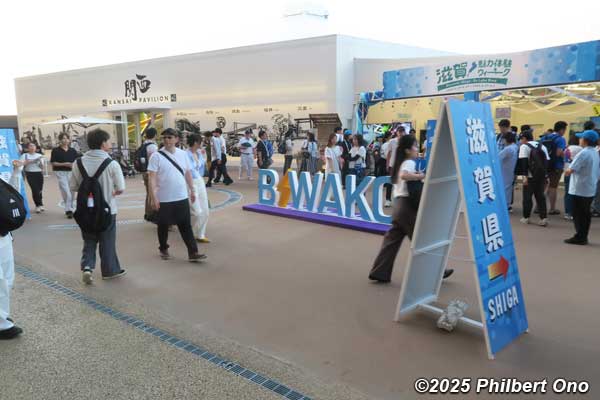
While Osaka has its own Osaka Healthcare Pavilion, the Kansai Pavilion houses the other Kansai prefectures (Shiga, Kyoto, Hyogo, Nara, Wakayama, Mie, Tottori, Tokushima, and Fukui) with individual booths promoting themselves to attract more tourists.
Shiga’s main presence at Osaka Expo 2025 is the Shiga Booth inside the Kansai Pavilion. I haven’t been inside the Kansai Pavilion (too hard to make reservations), so I can’t describe the Shiga booth, but it focuses on Lake Biwa (“Mother Lake”) with the theme of “Sustainable Living with Lake Biwa” using mainly videos.
For some shortsighted reason, only Nara Prefecture does not have a booth inside Kansai Pavilion. The previous Nara prefectural governor decided against it. While faraway prefectures Tottori, Fukui, and Tokushima have a booth, Nara, right next to Osaka, has no booth. Must be embarrassing for Nara people to be missing in the pavilion. To miss a major international PR opportunity like this that might come only once every 20 or 55 years.
The only problem with the Kansai Pavilion is that it requires reservations (after you obtain an Expo ID and buy your Expo ticket) which can be complicated to figure out and hard to come by even if you do figure it out.
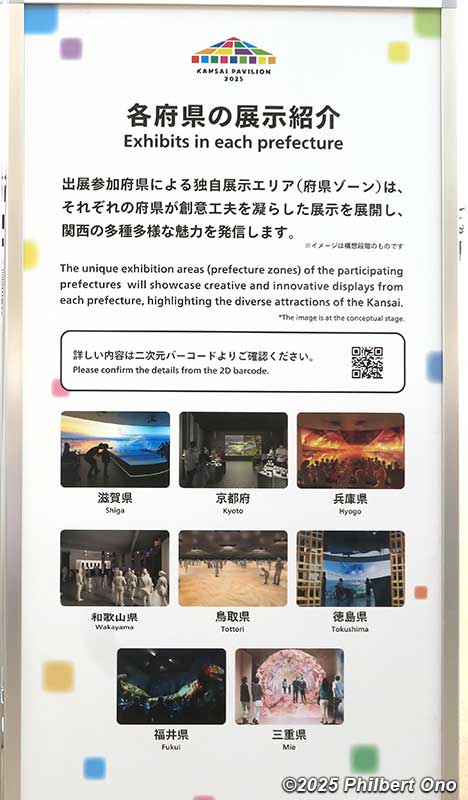
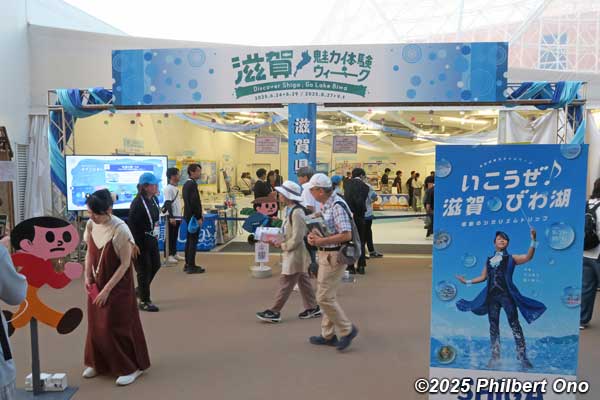
Fortunately, Kansai Pavilion has an adjacent space which does not require reservations. It’s a semi-open air space right next to the pavilion on the right. It’s used for supplemental events such as hands-on activities, craft exhibits, etc.
During June 24th to 29th, the Shiga booth used this space for Shiga Week (滋賀魅力体験ウィーク) when various Shiga organizations exhibited their crafts and activities. I went to see it on June 28 (Sat).
All Kansai prefectures are holding their own PR event week at Kansai Pavilion (schedule here). No reservations required and anyone can drop in. There will be another Shiga Week at Kansai Pavilion during August 27 to September 1, 2025.
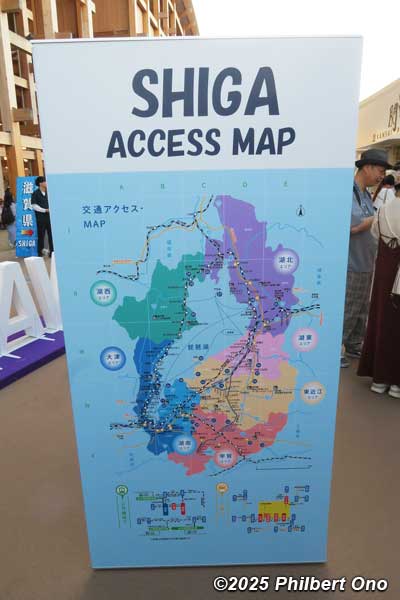
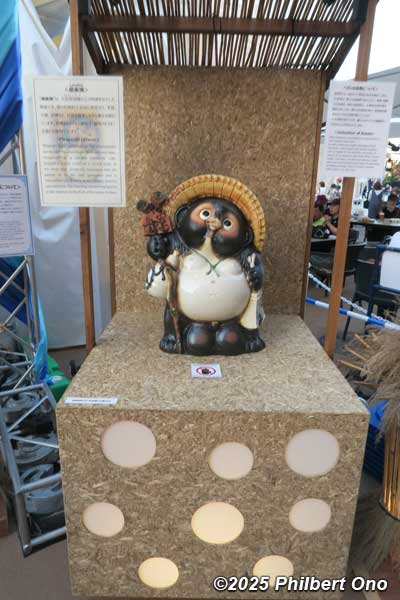
Complementing the Shiga Week venue at Kansai Pavilion were a map of Shiga and a tanuki raccoon dog statue from Shigaraki.
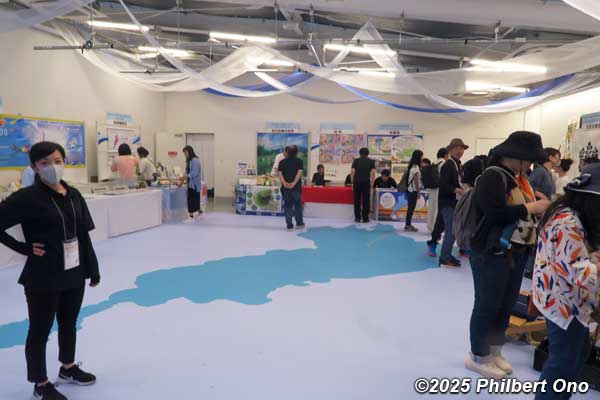
Shiga Week had hands-on activities like making your own bath salts using herbs from Mt. Ibuki, making paper fans, and sutra copying guided by Enryakuji Temple. Hours were 10:00 am to 7:00 pm. I saw it for only 10 min. from 6:50 pm just before closing time, so it wasn’t that crowded.
The space had several exhibitors and they changed most every day of Shiga Week. When I visited, I found the following:
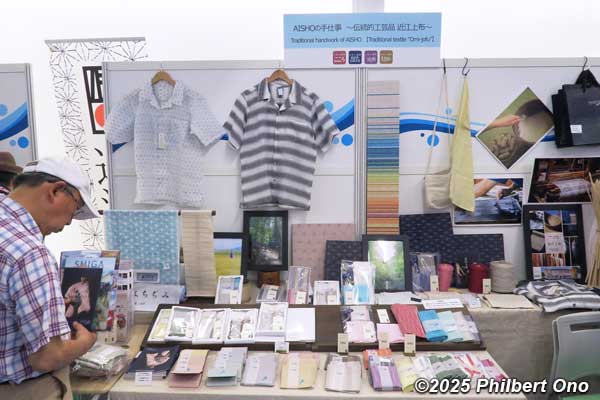
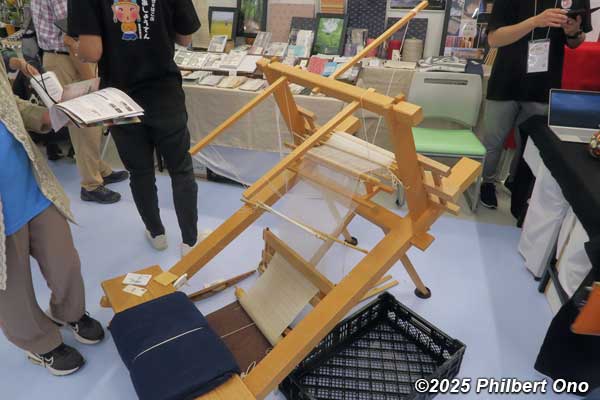
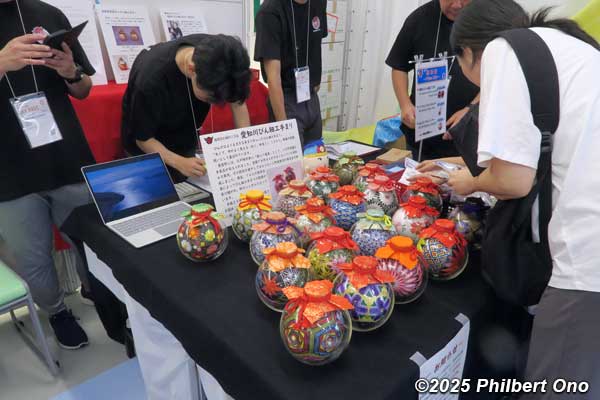
From Aisho Town were the Omi Jofu Traditional Kogei Center and the Aisho Town government. The Center showed Omi-jofu fabric (近江上布), and the town government showed bin-temari (glass ball with a threaded ball inside).
Omi-jofu is a high-quality fabric geared for cool summer wear. It’s certified as a Japanese traditional craft (one of three in Shiga, the other two being Shiragaki pottery and Hikone Buddhist altars). It’s woven with Omi hemp or ramie grown locally. There was a traditional loom for people to try weaving hemp cloth.
In Aisho, visit the Omi Jofu Dento Sangyo Kaikan (Omi Jofu Traditional Kogei Center 近江上布伝統産業会館) to see Omi hemp and ramie fabrics on display and for sale. Hands-on weaving lessons also offered (reserve by phone).
Aisho’s (or Echigawa’s) bin-temari threaded ball history goes back to around 1840 when its oldest bin-temari was made. This traditional art once died out in 1973 with the passing of Echigawa’s last bin-temari maker. Fortunately, the craft has been revived.
You might wonder how they fit the temari threaded ball into the round glass bottle. The threaded ball is actually hollow like a balloon. It is inserted into the bottle in a deflated state, then expanded into a ball.
To see more, visit the Bin-Temari no Yakata Museum (愛知川びん手まりの館) next to Echigawa Public Library.
Both the Omi Jofu Traditional Kogei Center (closed on weekends and national holidays) and Bin-Temari no Yakata Museum are near Ohmi Railways Echigawa Station. Free admission. Map
Another Shiga Week booth was Biwako wo Matou which makes and sells accessories like pendants, earrings, and brooches. It displayed Lake Biwa-shaped accessories made of plastic bottle caps! The blue color comes from blue bottle caps.
The plastic bottle caps are melted into a sheet (not mold) which the artist (named akiina あっきーな) then carefully cuts into Lake Biwa-shaped accessories. All unique color patterns. Made of upcycled materials. Upcycling is the process of reusing discarded waste items to make something of higher value. She also uses beach glass and pottery shards to make other accessories.
I was most surprised when she told me the prices. The small Lake Biwa brooch was ¥8,000 and the large one was ¥20,000! It certainly has higher value than the original, worthless waste materials.
She sells her accessories only at certain events and not even online. Based in Kusatsu, she has a website, but no online store: https://biwakowomatou.com
Shiga Week did quite well, attracting about 9,000 to 10,000 people every day. The next Shiga Week at Kansai Pavilion will be August 27 to September 1, 2025. Schedule here)
Jellyfish Pavilion (Signature pavilion)
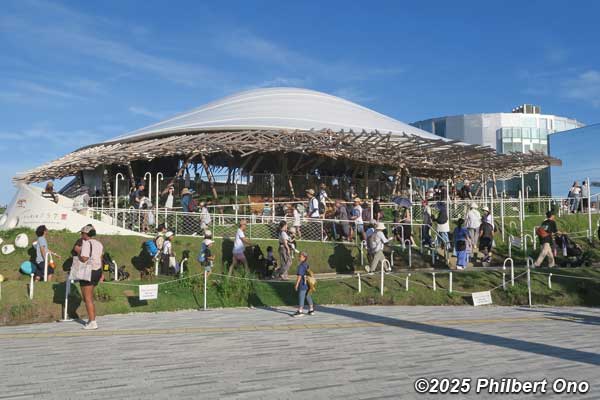
Besides the Kansai Pavilion, other things and people from Shiga are making their mark at Osaka Expo 2025.
Be sure to check out the Jellyfish Pavilion (Kurage-kan クラゲ館) produced by pianist and educator Nakajima Sachiko. It’s one of the eight signature pavilions around Inochi Park near the expo’s waterfront. This pavilion focuses on creativity. Jellyfish Pavilion has Shigaraki ceramic tiles.
Jellyfish Pavilion is on a low hill. There are two areas. The hilltop area called Play Mountain is open to all, and no reservations are necessary. Very quick to enter this area. Only the area in the basement requires reservations.
Just walk up the gradual slope to the hilltop where kids can play and create around the Tree of Creation.
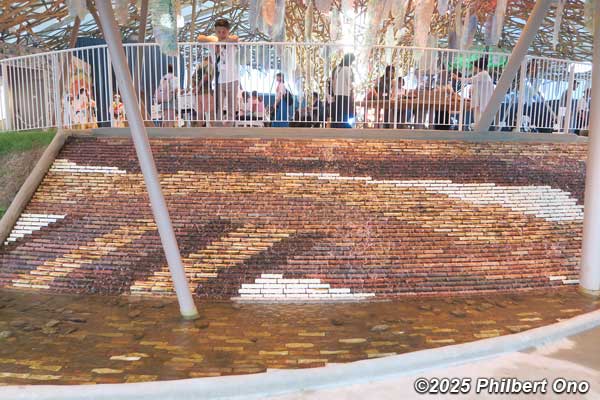
On the way up the hill, you’ll see ceramic tiles covered with falling water. This waterscape installation is called “Soil and Water Curtain” (土と水のカーテン) created with ceramic tiles presented and supplied by the Six Ancient Kilns (Rokkoyo 六古窯).
They are Echizen ware (Echizen, Fukui), Seto ware (Seto, Aichi), Tokoname ware (Tokoname, Aichi), Shigaraki ware (Koka, Shiga), Tamba ware (Tanba-Sasayama, Hyogo), and Bizen ware (Bizen, Okayama). They are considered to be Japan’s most prominent pottery producing areas since medieval times. These six kilns are in their own association (六古窯日本遺産活用協議会).
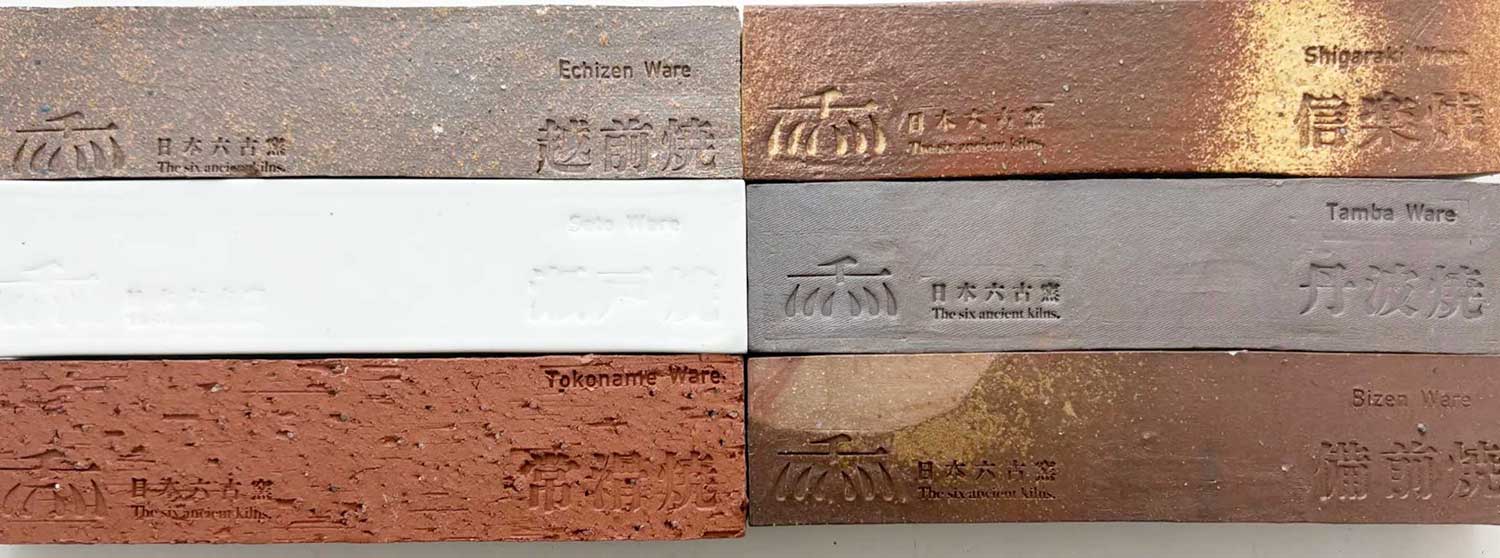
For this installation, the Jellyfish Pavilion has 3,205 tiles made by kids at Japan’s Six Ancient Kilns in five different prefectures. They used a wooden mold to shape the tiles using the clay of their respective area/kiln.
Some 726 of these tiles were made in Shigaraki. The fiery yellow-brown tiles are from Shigaraki, made by 17 students at Shigaraki High School and Shigaraki Junior High School.

If you look closely, you might see the kiln’s markings on a few of the tiles.
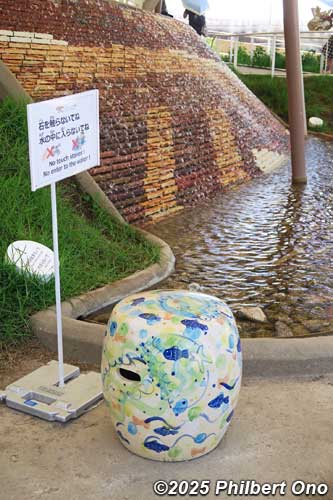
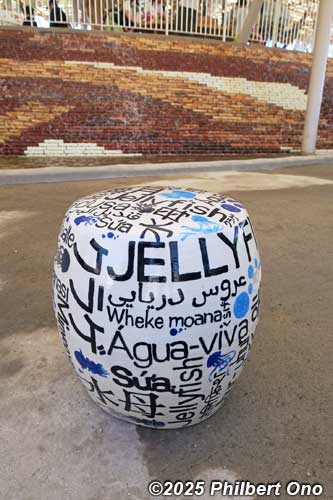
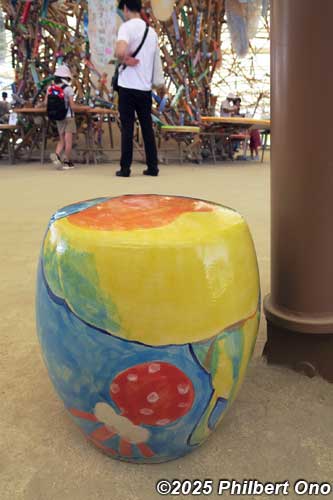
The pavilion also has nine colorful stools made of Shigaraki-yaki pottery. You can see them near the ceramic tile installation and on the hilltop area. You can sit on it to rest.
The stools were made and designed by students at Shigaraki High School and Shigaraki Junior High School in autumn 2024. The students made 20 ceramic stools, and pavilion producer Nakajima Sachiko and her team selected nine of them for the pavilion. The stools actually make a musical sound when you hit it. Almost like a percussion instrument.
A marvelous use and display of Shigaraki pottery. Pottery certainly evokes creativity and playfulness. (The pavilion doesn’t keep any real jellyfish nor aquarium.)
Earth Mart (Signature pavilion)
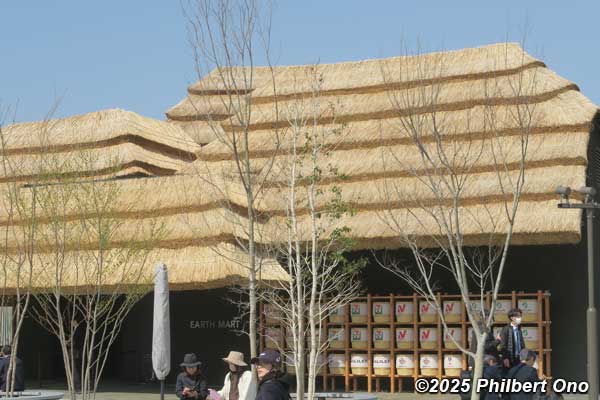
Another Signature pavilion, called Earth Mart, has a thatched roof made of thatch (reeds) from five locations in Japan: Hiruzen, Okayama; Yodogawa, Osaka; Aso, Kumamoto; Gotemba, Shizuoka; and Omi-Hachiman in Shiga. Reeds are another symbol of the cycle of life.
The reeds (thatch) from Omi-Hachiman were harvested in February 2024 from the Maruyama district (Lake Nishinoko 西の湖) by 110 people from 20 local companies, schools, and organizations in Omi-Hachiman. One of them was confection maker Taneya whose La Collina confection shop is adjacent to reed fields.
After harvesting, the reeds were dried before being transported to the expo site in November 2024 to build the Earth Mart’s roof.
Reeds from Shiga are called Goshu yoshi (江州ヨシ). They can grow quite high, three to four meters high. They wilt during winter which is harvest season. They are traditionally used to make window blinds, indoor fixtures, and partitions. In spring, new reed seedlings sprout.
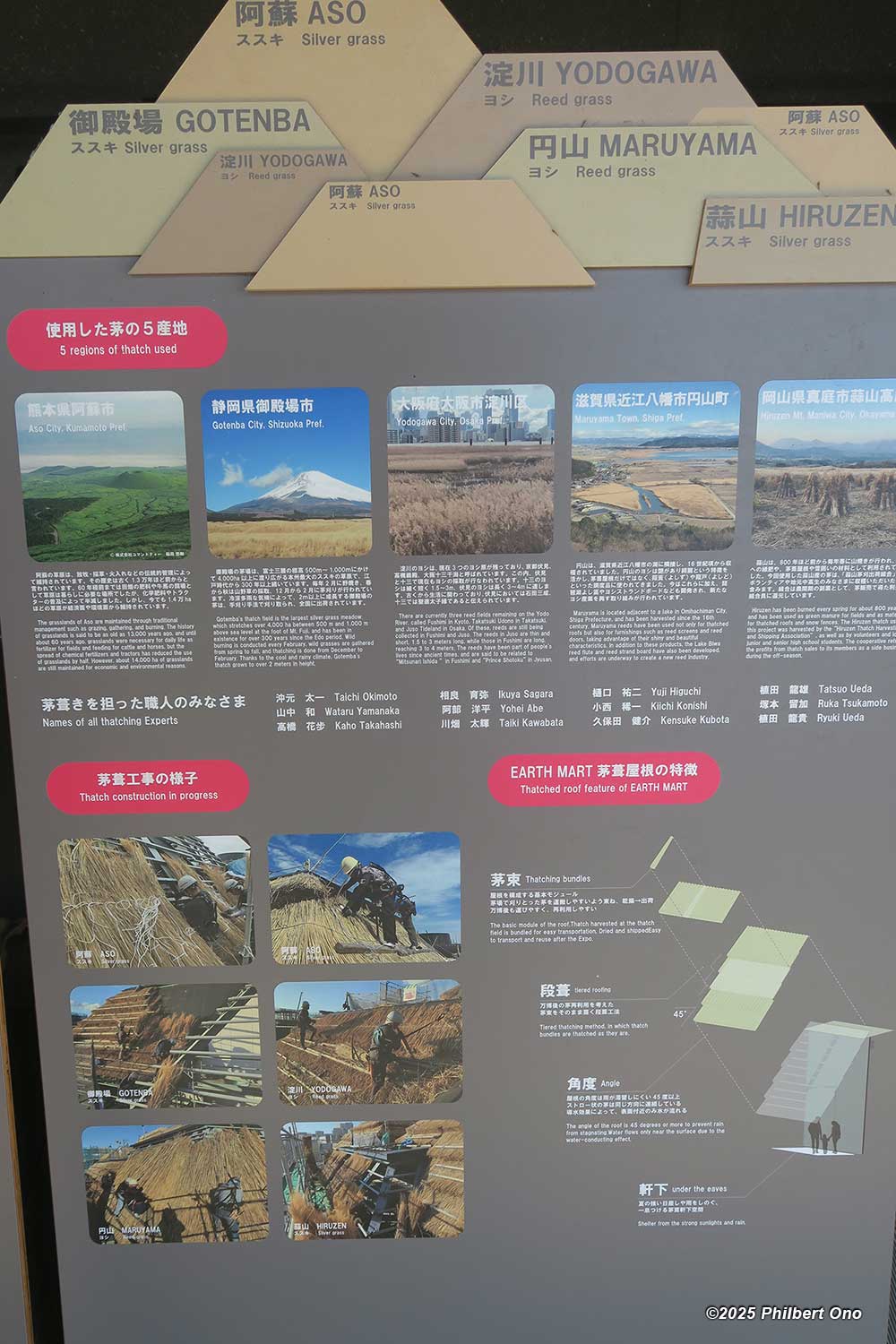
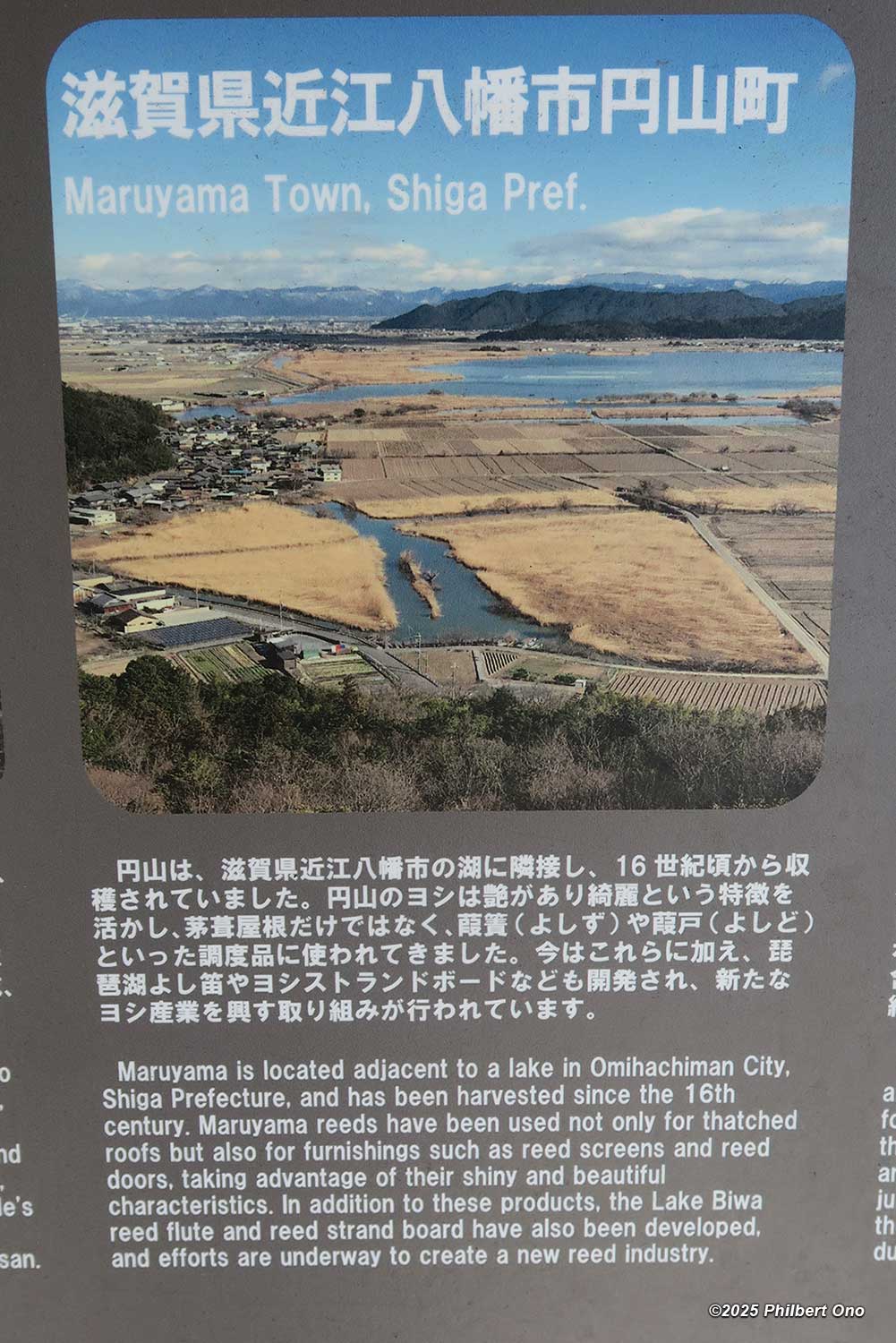
Maruyama is noted for suigo boat rides through the reeds near Lake Nishinoko. Reed fields are essential to purify the lake water naturally and to provide a protective habitat for baby birds and fish.
Produced by writer Koyama Kundo (小山薫堂) and designed by architect Kengo Kuma, Earth Mart’s main theme is food and life. The pavilion is acclaimed, but hard to get reservations to enter.

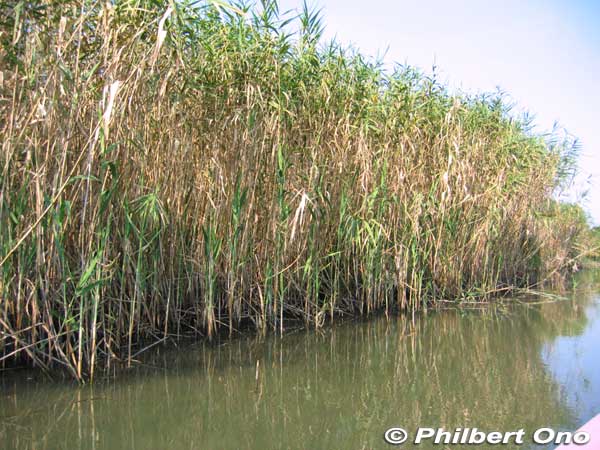
Future of Life (Signature pavilion) – Ishiguro Hiroshi from Takashima
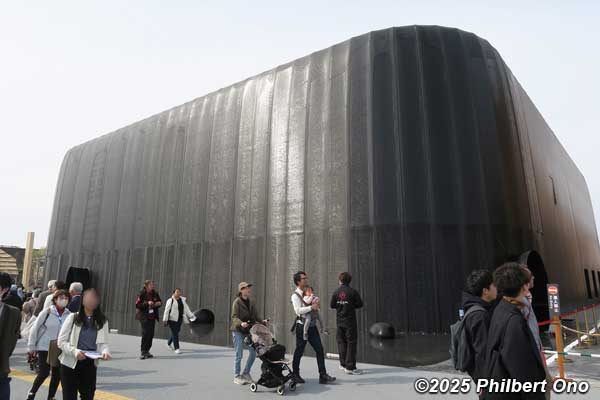
Another popular Signature pavilion is Future of Life (いのちの未来), produced by world renown roboticist Ishiguro Hiroshi (石黒 浩) who is an ATR Fellow and professor at University of Osaka and native of Takashima, Shiga Prefecture. When he was seven, he visited Expo ’70 in Osaka during the hot summer and was inspired by expo pavilions (Midori-kan). He also noticed that many of the futuristic products introduced at Expo ’70 came true by 50 years later.
He has been researching and developing humanoid robots since college. He seems eccentric, but undeniably brilliant for his ideas regarding robotics and how it can help humans.
The pavilion features androids and robots and how they could be integrated into human society in the future.
He says that humankind is the only species on Earth which can use science and technology to extend and advance one’s abilities. It can expand the possibilities of life. No doubt, his pavilion and ideas may become an inspiration to kids today who will see life 50 years from now. Sadly, Japan’s population will substantially decline by then. That’s why such androids combined with A.I. need to be developed to help rectify the labor shortage, says Ishiguro.
Geminoid HI-6
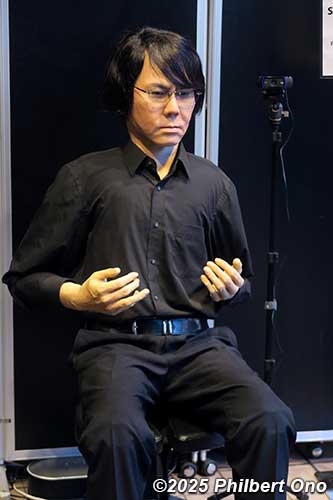
Geminoid HI-6 is the name of Ishiguro’s android robot that looks like him. It moves (facial expressions and upper body movements) and talks. It’s operated remotely. The head is made of plastic, skeleton is metal, and skin is silicon. It’s the latest version of his android under development since 2006. Geminoids are androids which closely resemble an existing human person.
If you look at the face closely, it’s quite realistic. The eyebrow hair, skin, eyelids and eyelid folds, etc. Ishiguro even uses this android to teach his college classes.
We’ve seen his Geminoids in Japan since almost 20 years ago. The resemblance is amazing. Although it still looks like him now, I wonder if he will update it with aged features maybe 20 years from now when he will look older. For the time being, he probably won’t change his hairstyle, hair color, or wear anything other than black.
Life in 2072 Exhibition
Ishiguro’s android was the main attraction at the Future of Life signature pavilion’s spinoff exhibition named Life in 2075 held on July 19th–23rd, 2025 at Gallery EAST (Ray Garden). Visitors with timed-entry tickets could talk to his Geminoid for 5 minutes.
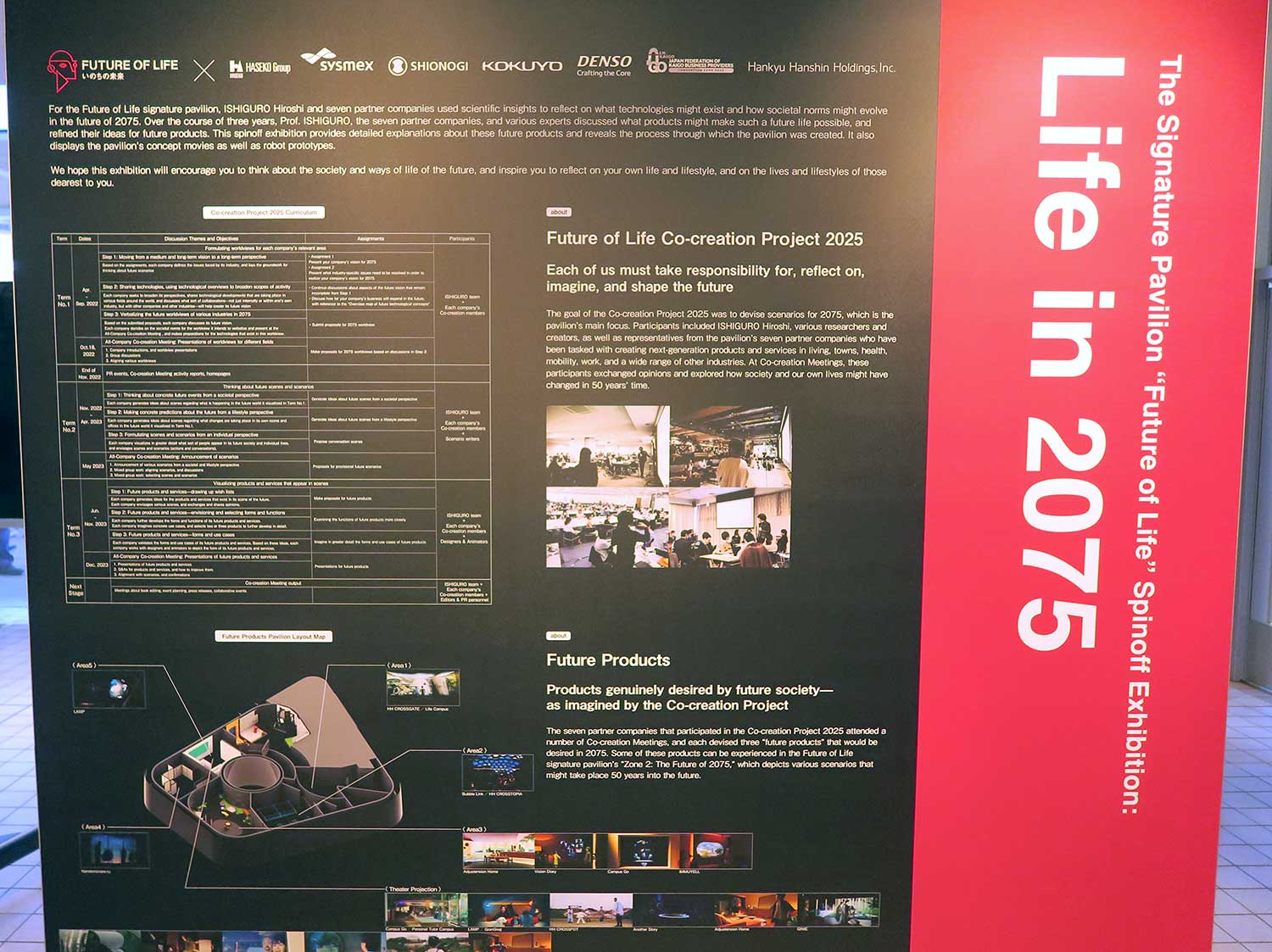
「2075年のくらし展」
The “Life in 2075” exhibition showed what life 50 years from now might look like, with plausible future products and robots/androids of course.
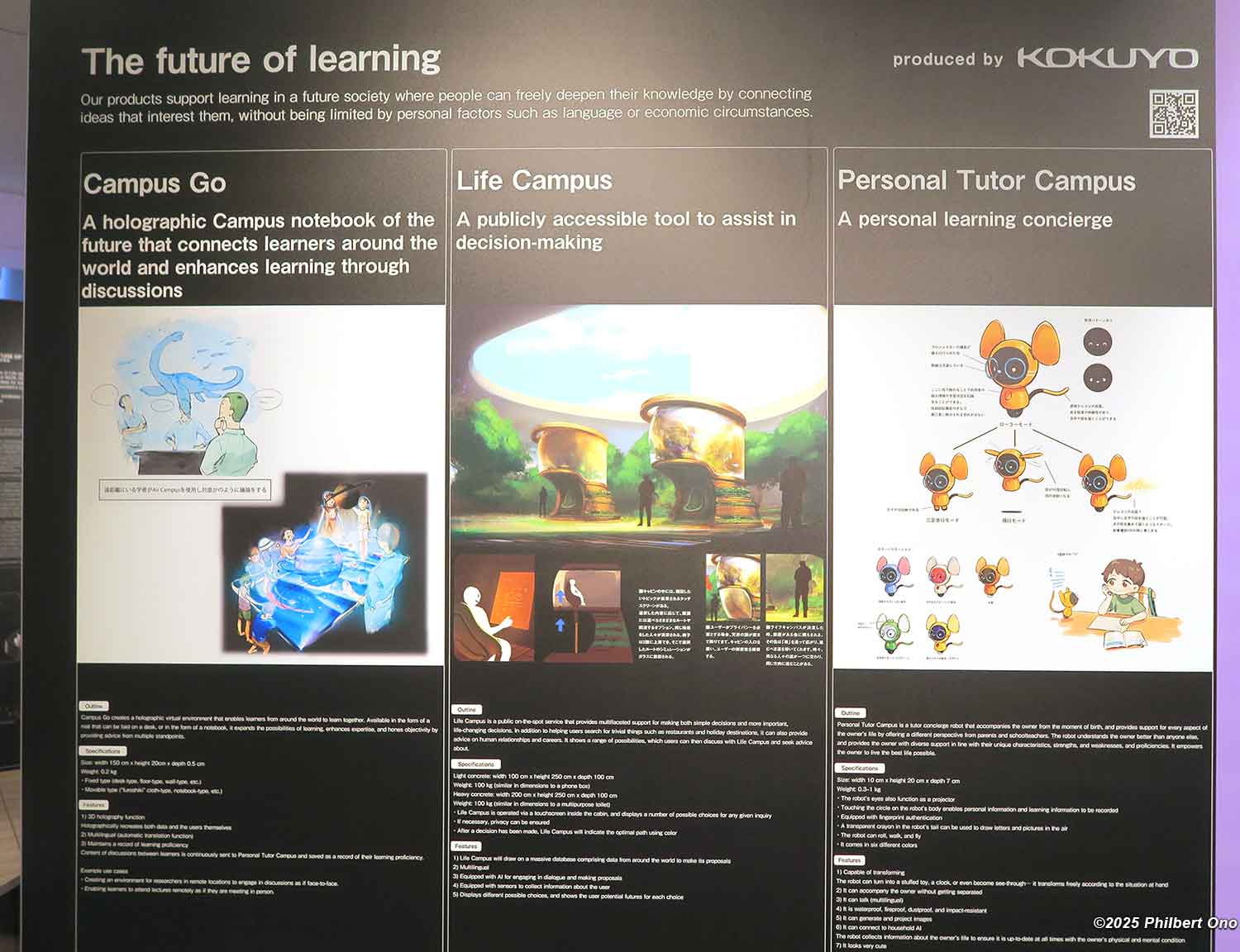
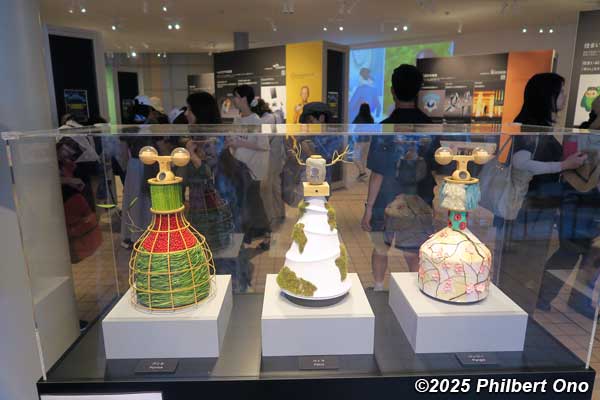
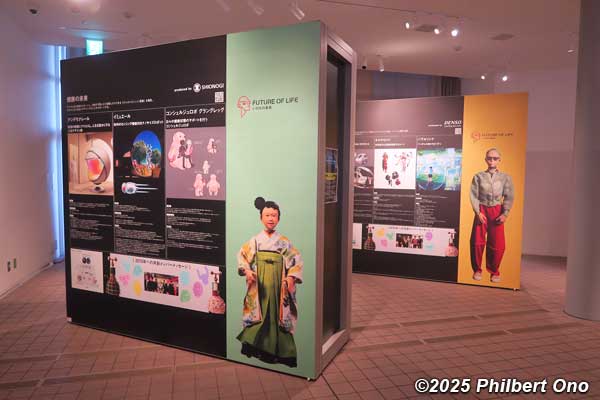
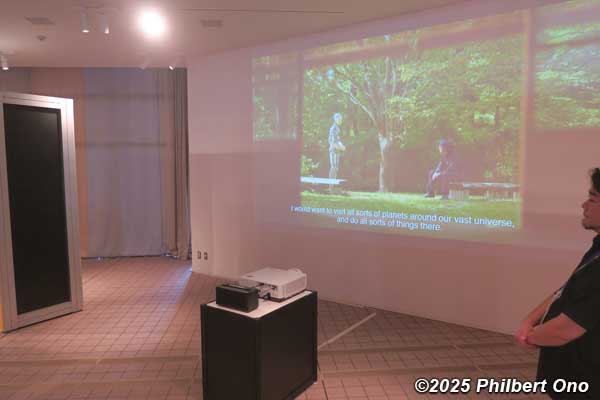
Videos with English explaining more about Ishiguro and the ideas behind the pavilion.
Another video from a news program: https://youtu.be/4iVRvpXFDsg?si=WJXU7WwCtRBXHb16
Future Life Village
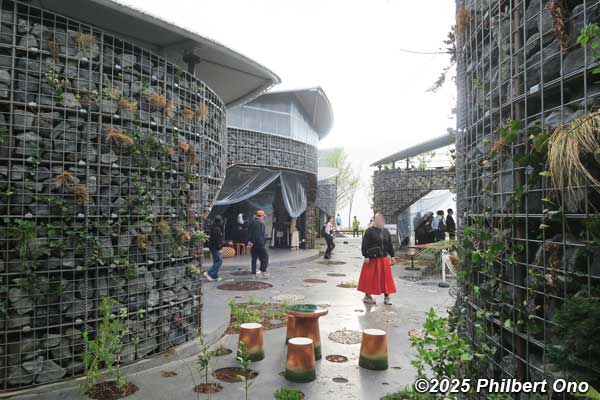
Another Shiga egg tucked away at Expo 2025 is this set of outdoor stools and table made of Shigaraki-yaki pottery at Future Life Village near the West Gate. The ceramics were mixed in with waste materials and created by the Association of Shigaraki Ceramic Companies (信楽陶器工業協同組合).
The clay was then used to make the stools and table by Marushi Seito Co. (丸滋製陶株式会社). Look at the stools closely for designs of Lake Biwa fish (nigorobuna carp).
Future Life Village has several small buildings with curving stone walls. The theme keeps changing inside the buildings including Team Expo. Also known for limited-edition rubber stamps.
Note that the expo has many pavilion names with the word “future.” It can be confusing and hard to remember. The above Future of Life and Future Life Village are examples.
Zannen-ishi Toilet (Traces of Earth)
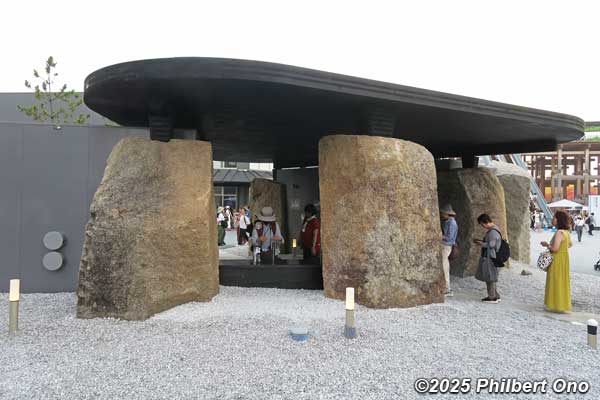
Expo 2025 has a number of unique designer toilets. One is the Zannen-ishi Toilet with five huge boulders originally quarried to rebuild Osaka Castle 400 years ago. However, for one reason or another, they were not selected for the castle. They were abandoned and nicknamed Zannen-ishi (残念石) or Rejected Stones. The toilet is like a stone garden or perhaps we should call it a “boulder garden.”
Zannen-ishi Toilet was designed by a young architect from Omi-Hachiman named Ohno Hiroshi (大野宏). He used to build structures in poverty areas in developing countries. Now he likes to use natural materials in his structures including bamboo and thatch (reeds). Very innovative looking buildings.
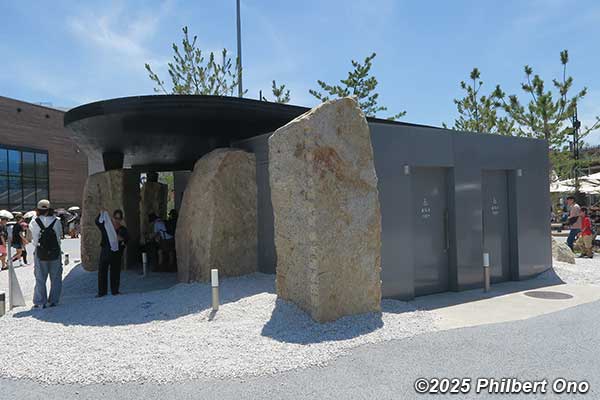

These boulders were originally quarried from Mt. Ono (大野山) in Kizugawa, Kyoto Prefecture.
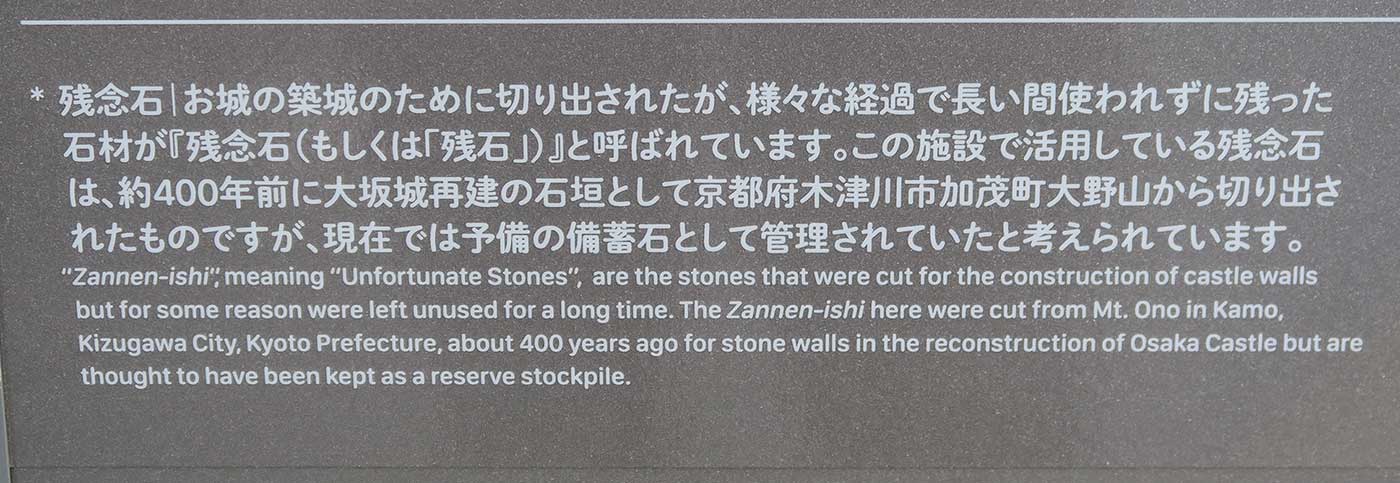
Shiga-ken Day (July 24) – Shining Hat
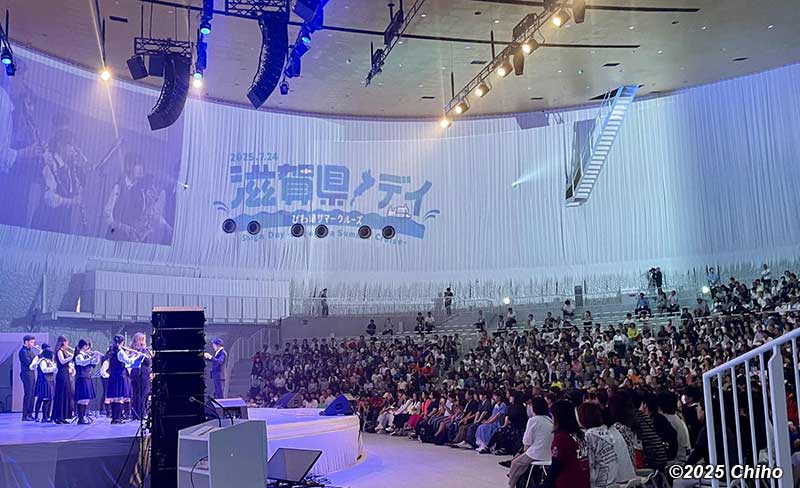
Another major Shiga event at Osaka Expo 2025 was Shiga Day or Shiga-ken Day (滋賀県デイ) on July 24, 2025. It was a day-long program at Shining Hat (シャインハット), an indoor event hall with a capacity of 1,900.
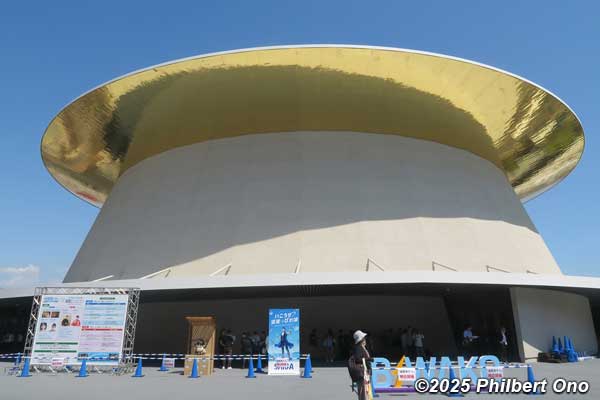
Shiga-ken Day program was split into Part 1 and Part 2. Reservations were not required, but it was first-come, first-served at the door for Part 1 when doors opened at 10 am. Program started at 11:00 am.
For Part 2, 500 timed-entry tickets (seiriken) were distributed that day from 9:15 am in front of Shining Hat’s Information counter, and another 500 tickets from 11:00 am.
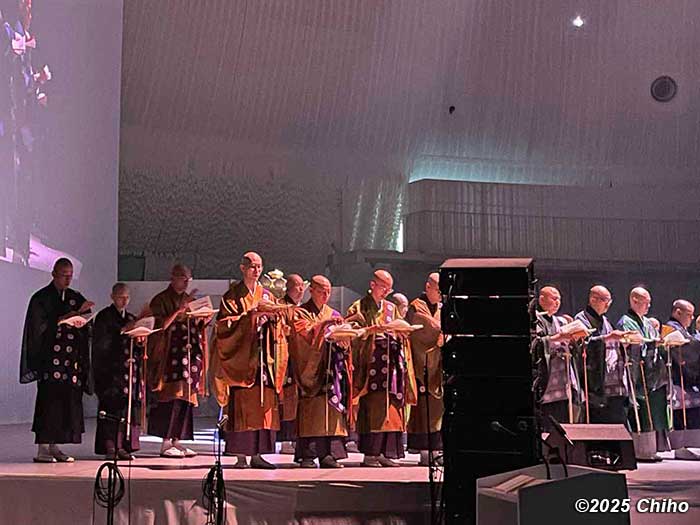
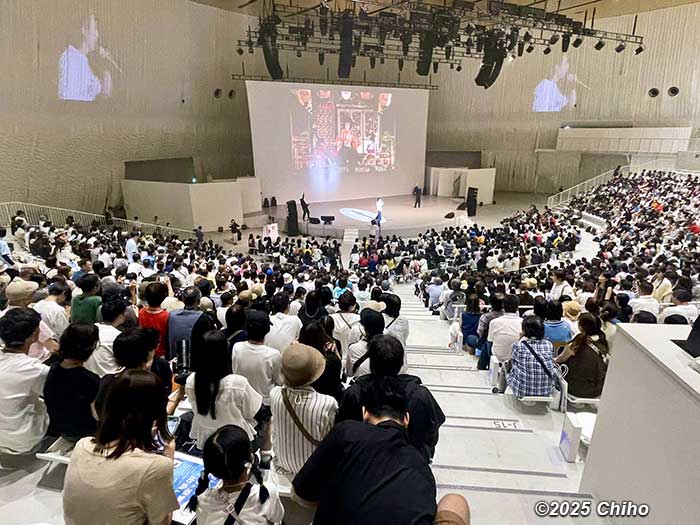
Right: Shining Hat audience seats. (Thanks to Chiho for photos.)
Part 1 – 11:00 am–1:45 pm
Program included stage entertainment by Shiga performers from local schools and troupes, chanting by Enryakuji Temple priests, and a talk show. The design motif was based on the Uminoko Floating School. Hiko-nyan and Myaku-Myaku mascots also appeared.
Enryakuji Temple’s eternal flame in a brass lantern from Konpon Chudo Hall was displayed from noon for only 50 minutes. At 12:30 pm, Sanyare dance (UNESCO Intangible Cultural Heritage) from Kusatsu was performed.
Part 2 – 4:00 pm–7:00 pm (Doors open at 3:00 pm.)
Program included Hiko-nyan and Myaku-Myaku mascots. Talk show with pop singer Nishikawa Takanori and Paralympic swimming gold medalist Kimura Keiichi. Music and dance by Shiga performers young and old, including Goshu Ondo bon dance.
The climax was a live performance by Nishikawa Takanori from 6:30 pm. He has a large fan base, so we can expect a long line for timed-entry tickets and a full house.
More info: https://www.oricon.co.jp/news/2391255/full/

Couldn’t find any good YouTube videos of this event. Shiga Prefectural Government and tourist bureaus always say, “From Shiga to the world!” (「滋賀県から世界へ」), but they don’t provide any English.
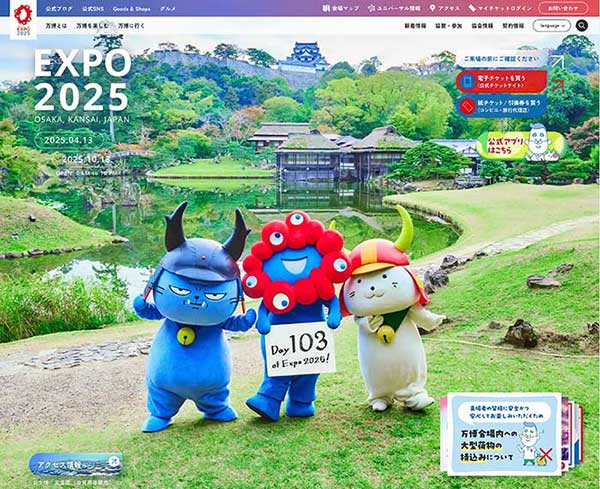
For Shiga-ken Day on July 24, Osaka Expo 2025 official website’s top page featured a photo of Myaku-Myaku (center) with Hikone mascots Waru-nyanko Shogun (わるにゃんこ将軍) on the left and Hiko-nyan on the right at Genkyuen Garden next to Hikone Castle (seen in the background). Great shot, although I don’t care for Waru-nyanko.
Hiko-nyan also appeared briefly in the Japan Day parade under the Grand Ring on July 3, 2025, but it was a pitiful parade. With so few people in the parade, it was like a joke. Major disappointment to those who waited in the heat to watch the parade, and major embarrassment for Japanese nationals for the host country to stage such a laughable parade. No offense to those who appeared in the parade though. They were fine.
EXPO Exhibition Center WASSE – Shiga exhibits
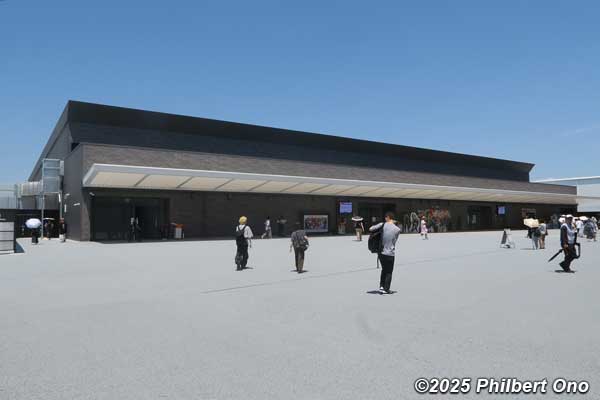
EXPO Exhibition Center WASSE is a large exhibition/event hall right outside the Grand Ring toward the West Gate. The building is usually partitioned into the North and South halls. There’s always something going on inside. It’s also a great place to cool off from the summer heat or shelter from sudden rain.
The following two Shiga-related exhibitions were in WASSE in July 2025: Birdman Rally Exhibition (July 23rd–25th, 2025) and Japan Annual International Art Festival (July 2nd to 6th, 2025)
Birdman Rally Exhibition – July 23rd–25th, 2025, WASSE North
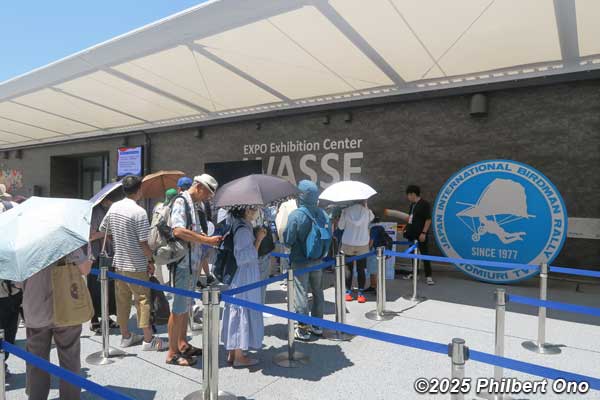
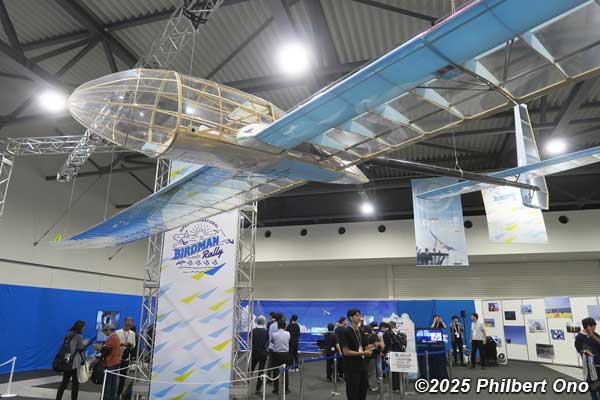
The Birdman Rally Exhibition (鳥人間コンテスト展) was held at EXPO Exhibition Center WASSE North on July 23 to 25, 2025 (10 am–8:00 pm). It promoted the progress of human flight and the annual Birdman Rally to be held on July 26–27, 2025 in Hikone, Shiga Prefecture.
Held since 1977, the Japan International Birdman Rally (鳥人間コンテスト) is an aviation contest of human-piloted gliders and human-powered, propeller planes flying over Lake Biwa from Matsubara beach in Hikone, Shiga Prefecture.
There are two contest divisions: Gliders which just glide (滑空機部門), and human-powered propeller planes (人力プロペラ機部門). The latter travels much farther with the propeller powered by the pilot pedaling like on a bicycle.
The winner is decided by the longest flight distance after the glider/plane is launched from a 10-meter high platform on the lake’s edge. The planes are designed and built mostly by Japanese college engineering or aviation club students as an engineering and technical challenge. There have been a few foreign teams as well.
The contest is both amusing and amazing. Amusing when the plane almost immediately crashes into the water upon launch. Amazing when it flies really far and for a long time (2.5 hours!). There are rescue motorboats and divers in the water to quickly pluck the pilot from the water and retrieve the plane.
Glider and propeller plane designs and flight distances have come a long way since the early years of the contest. Much more sophisticated now.
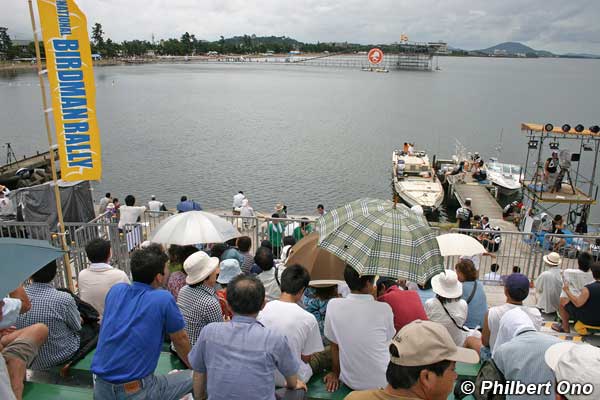
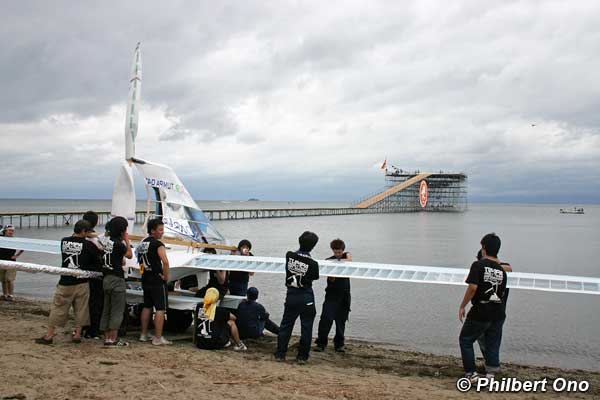
The event has long been sponsored and broadcast by Yomiuri TV. Osaka-based Iwatani Corporation, a gas company, is also a sponsor since 2010.
During the Birdman Rally, there are free shuttle buses from JR Hikone Station to the venue. This year’s contest will be broadcast on September 3rd, 2025 at 7 pm on Yomiuri TV (NTV network). Official website.
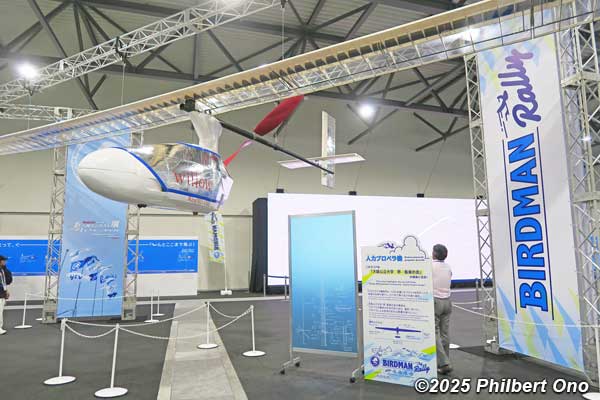
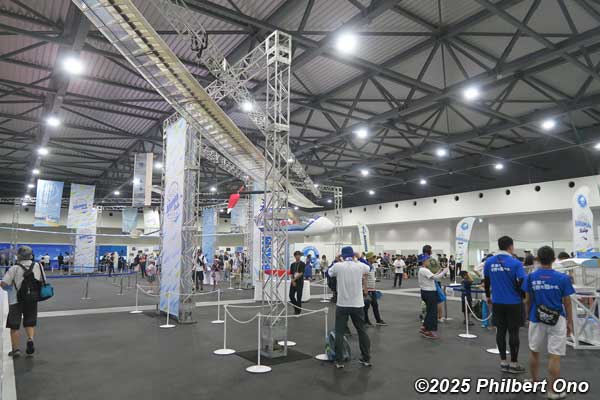
The Birdman Rally Exhibition was in the large WASSE North hall exhibiting actual planes used in the Birdman Rally. The hall also had human-powered flight simulators, paper plane workshops for kids, a large screen showing videos of the Birdman Rally, and photo exhibition.
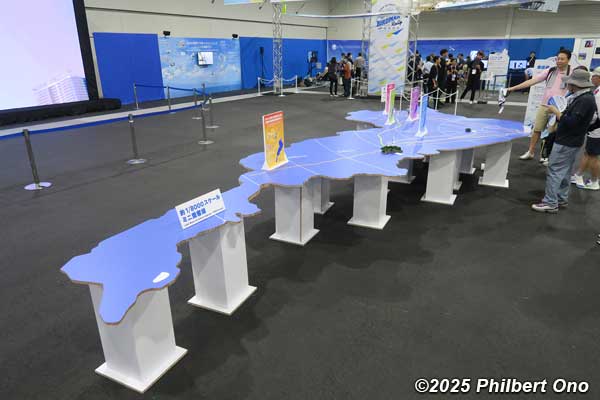

Another centerpiece exhibit was this large cutout of Lake Biwa showing the record-breaking flight paths of Birdman Rally gliders/planes. Longest distance with a prop plane was 69 km in 2023. This translated into 2.5 hours of almost non-stop pedaling! Pedaling a prop plane is like bicycling up a steep hill. Very strenuous.
Since the prop planes reached farther and farther distances, they had to change the rules to accommodate the longer distances. Now they have a circular route to follow around the lake instead of allowing the planes wander in any direction. Planes are not allowed to fly over land at all costs.
The glider flight distance record is 645.15 meters set in 2024.
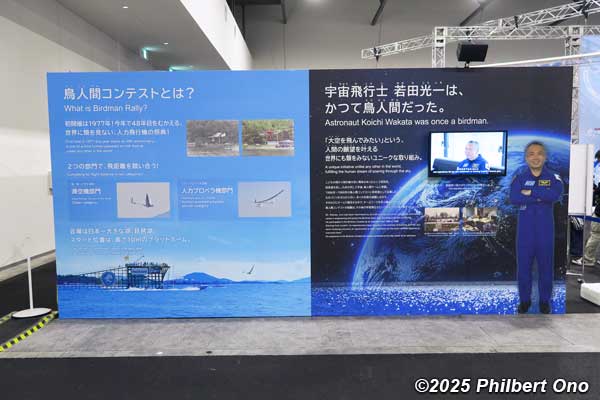
The hall entrance had a large panel showing retired Japanese astronaut Wakata Koichi. He logged over 500 days in space, mostly on the International Space Station. In 1986-88, he actually participated in the Birdman Rally while an aeronautical engineering student at Kyushu University. How about that?
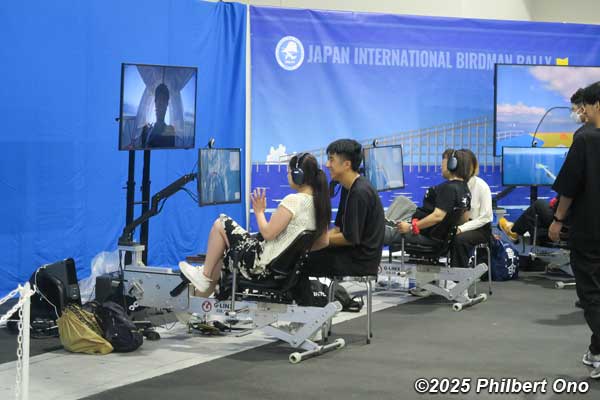
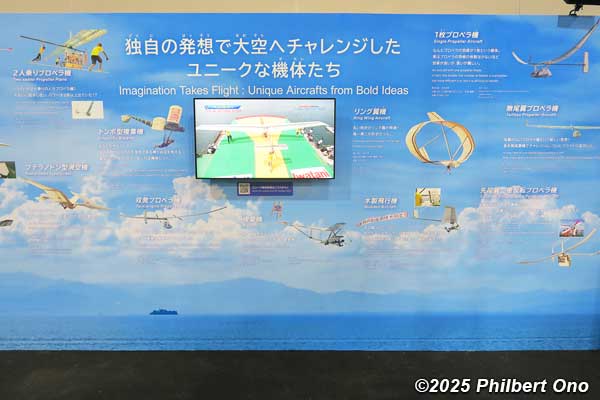
Right: Panel display of the history of human flight.
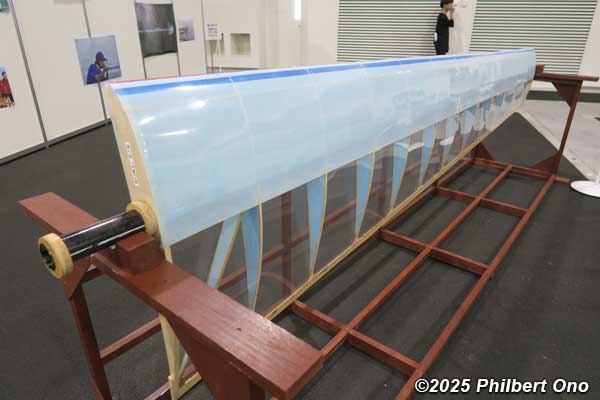
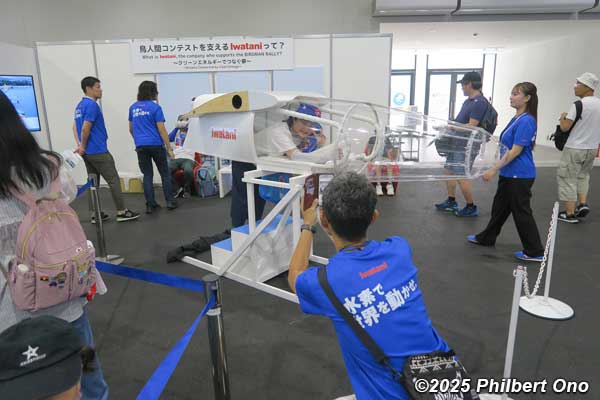
Left photo: There were other interactive exhibits like this wing which you could lift up. This large piece was absolutely featherweight! Constructed in 11 parts to make it easier to transport. Birdman plane construction materials include carbon fiber, balsa wood, hinoki cypress wood, styrene paper, and Styrofoam.
Right photo: Cockpit mockup for selfies.
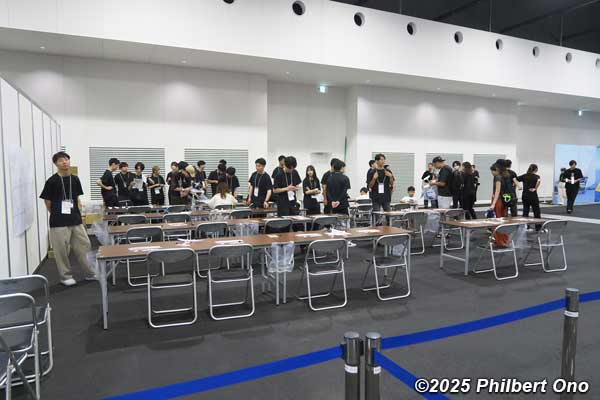
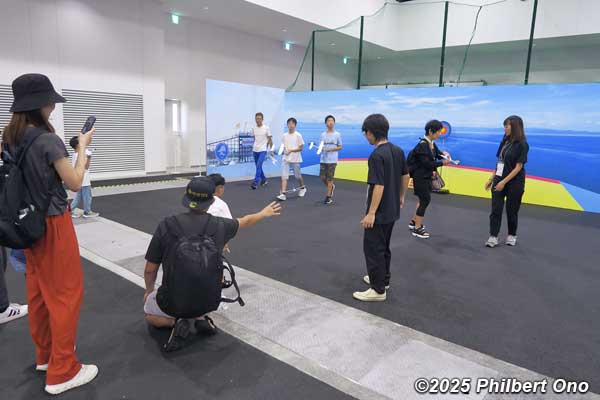
Right: Kids fly their handmade paper planes which they could take home.
Great that they also had these fun activities for kids to get them interested in flight. Who knows, a few of them might even become an airline pilot or even an astronaut someday. Twenty or thirty years from now, they might mention how they first got interested in aviation at Osaka Expo 2025.
Birdman Rally in Matsubara Beach, Hikone
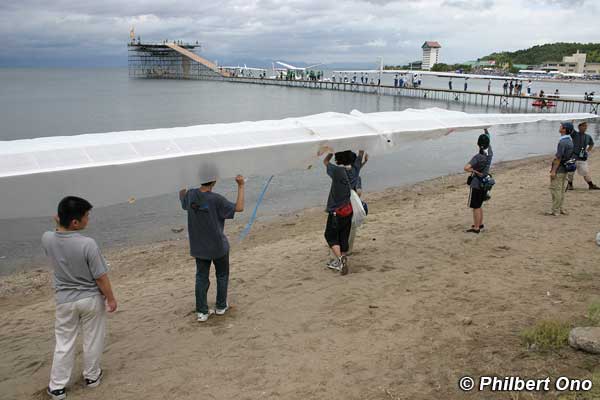
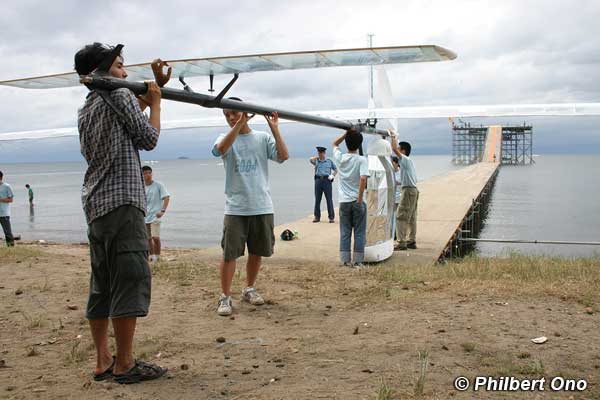
For the Birdman Rally, they park and prepare their planes on the beach before they carefully carry it to the launch platform.
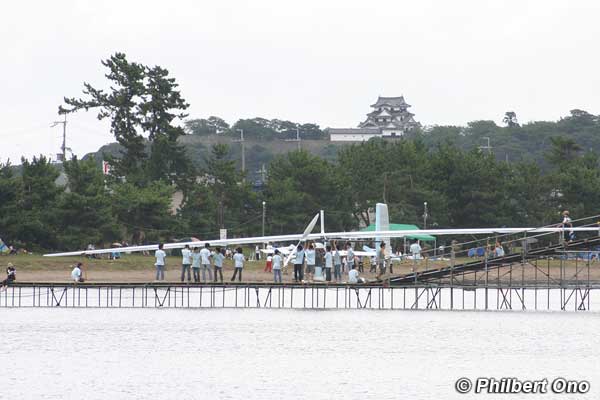
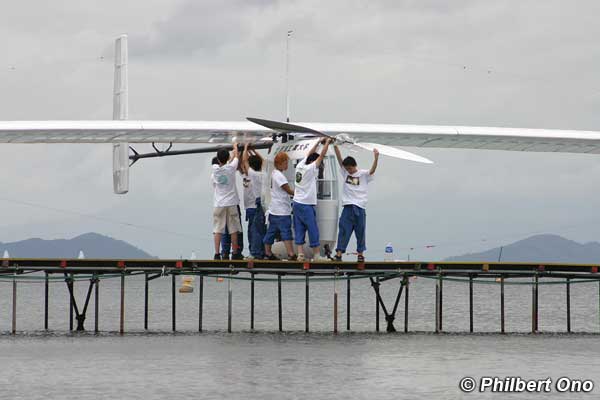
Hikone Castle overlooks Matsubara Beach. Unfortunately, on this day, the winds were too strong and they had to cancel part of the competition. Never got to see any planes in flight.
Official videos: https://www.youtube.com/@ytvbirdman
Website: https://www.ytv.co.jp/birdman/expo2025/
Japan Annual International Art Festival – July 2nd to 6th, 2025, WASSE North
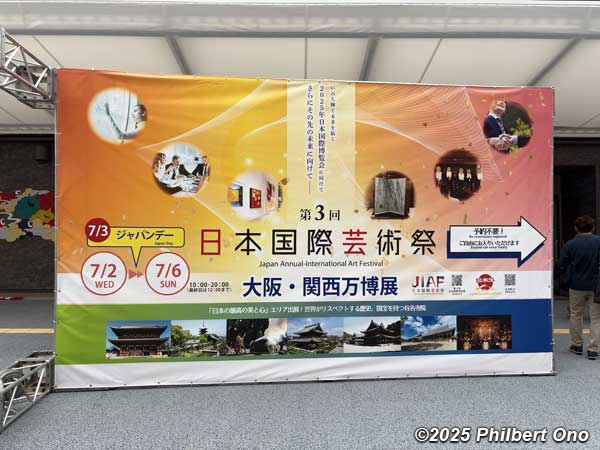
In conjunction with Japan National Day on July 3, Wasse held a large Japanese art exhibition called Japan Annual International Art Festival (日本国際芸術祭) during July 2nd to 6th, 2025.
Some 54 Japanese organizations and groups displayed their artwork and crafts. They included universities, artist groups, famous Buddhist temples, galleries, local governments, and companies. Art from Shiga was also exhibited.
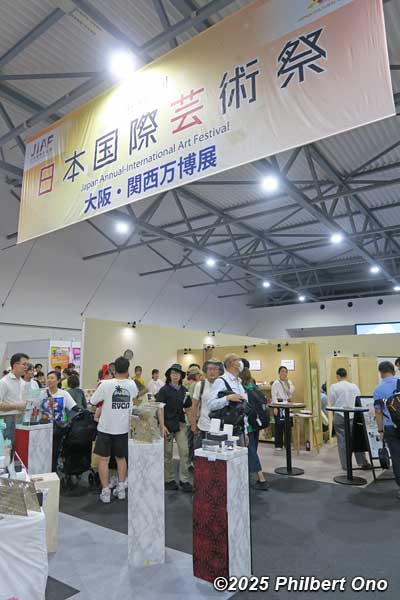
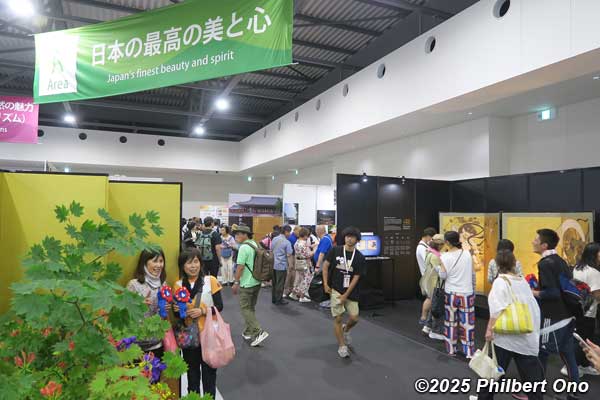
Japan Annual International Art Festival – Enryakuji Temple booth
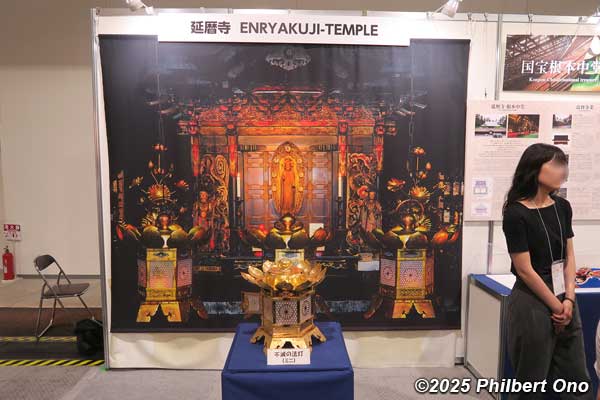
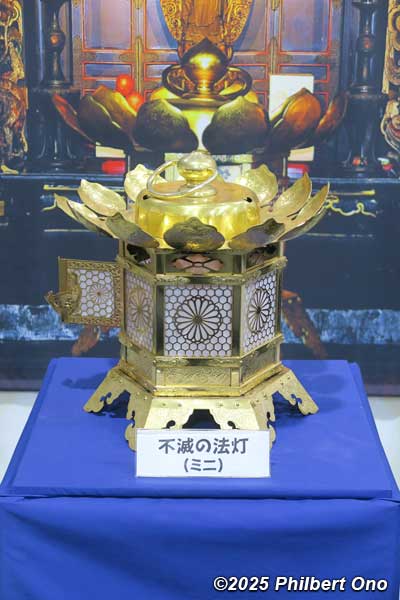
Enryakuji Temple (延暦寺) had a booth showing a small replica of one of the three brass lanterns inside the Konpon Chudo main worship hall (根本中堂). These lanterns contain eternal candle flames (Fumetsu no hoto 不滅の法灯) which were lit by Priest Saicho himself. Named the “Inextinguishable Dharma Lamp,” the flames have been burning continuously for over 1,200 years. (The replica has no flame.)
Behind the lantern was a large photo of Konpon Chudo‘s main altar.
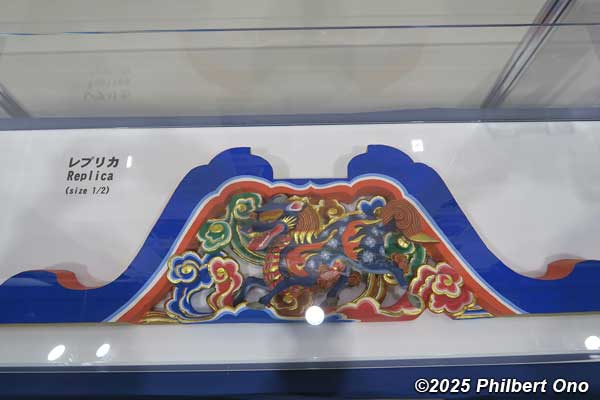
Small replica of one of the decorative woodcarvings called “kaeru-mata” (蟇股) which was relacquered in brilliant colors. They depict Oriental Zodiac animals and fantasy beasts.
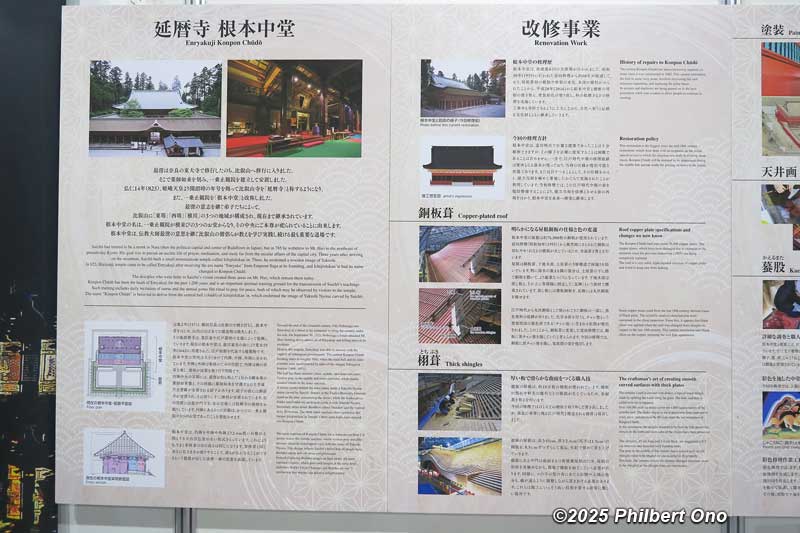
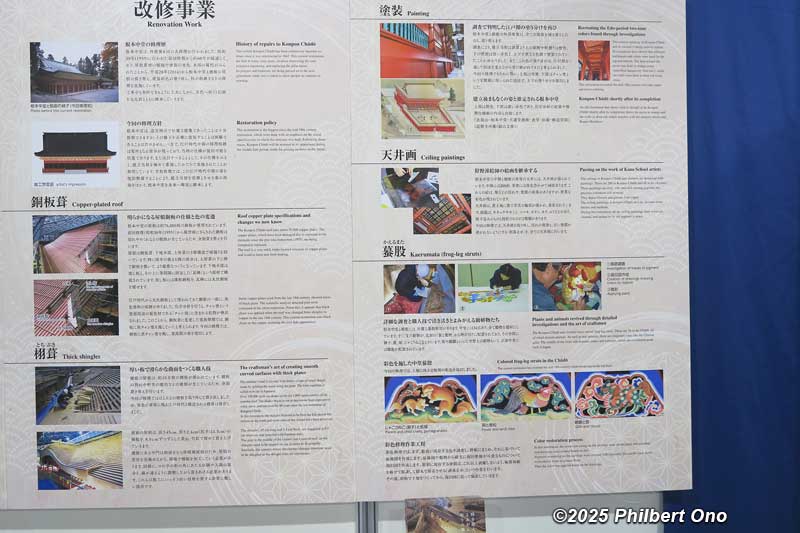
Enryakuji’s booth also had panel displays explaining Konpon Chudo main worship hall’s massive renovations ongoing since 2016. Read more about the renovations here…
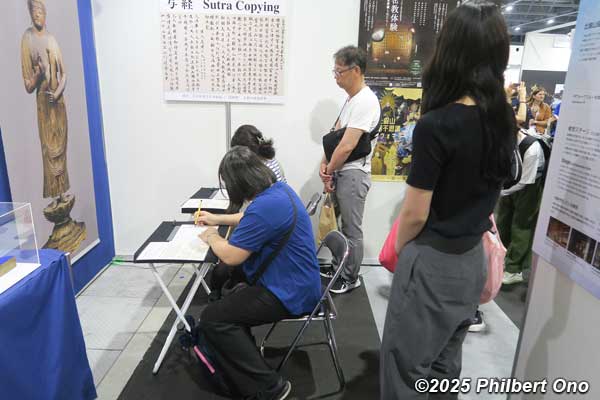
Japan Annual International Art Festival – Japanese-American-Chinese Joint Expo Art Exhibition (日米中ア-ティスト共創EXPO展)
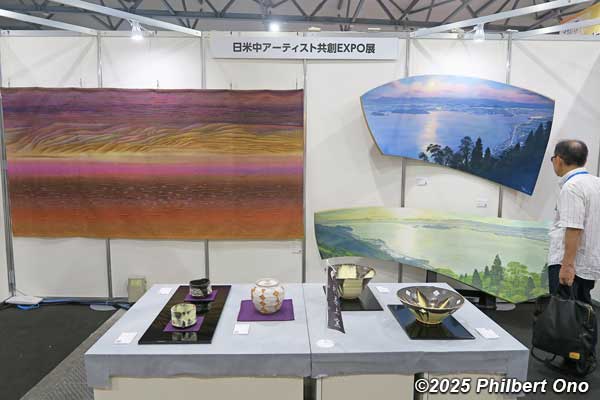
One of the many other booths at Japan Annual International Art Festival in WASSE was this art exhibition by an international group of artists from Japan, America, and China. There was pottery, fabric, and paintings.
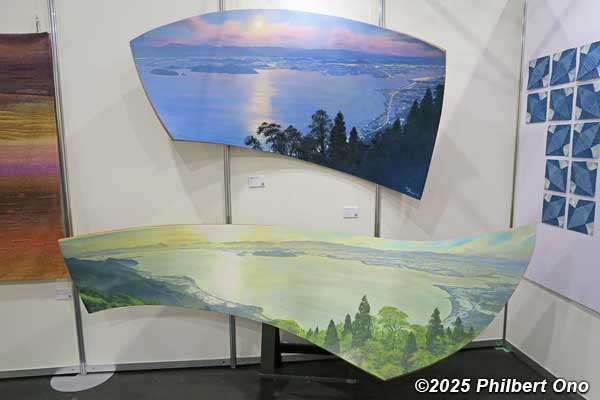
While peering into this booth, I immediately recognized one of the painters, Brian Williams and his unmistakable parabolic paintings of Lake Biwa (views from Mt. Hiei it seems). Beautiful. Wish there were more Shiga artists at the expo.
Austria Pavilion’s Austria-Shiga menu
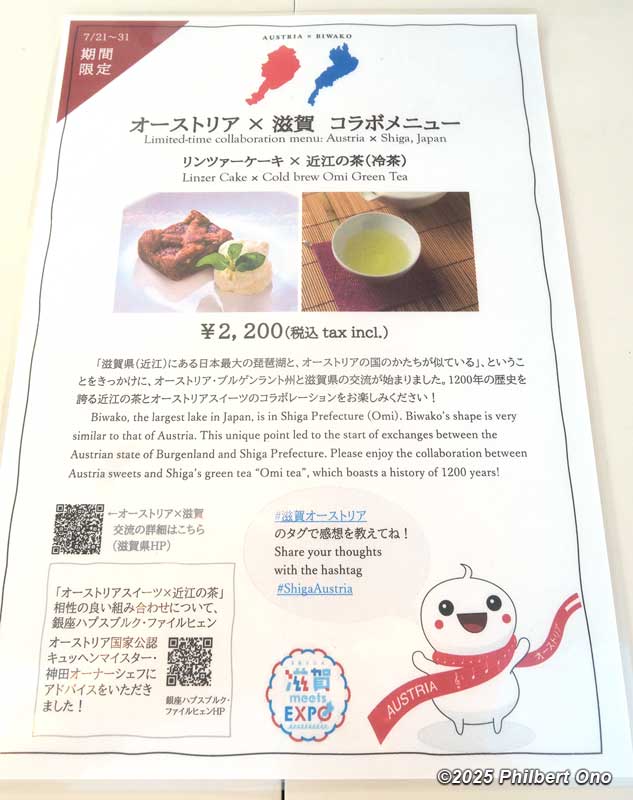
Shiga Prefecture and Austria have started cultural exchanges because the shape of Lake Biwa is similar to the shape of Austria!
To further celebrate this coincidence, the Austrian Pavilion’s restaurant has this limited-edition dish called “Linser Cake + Cold brew Omi-cha green tea.” How about that? Served for a limited time only from July 21 to 31, 2025. Only 50 servings a day. Restaurant doesn’t accept reservations.
Official stores – Shiga merch
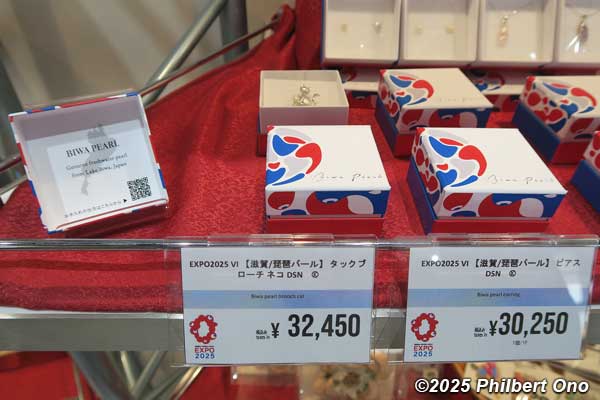
Osaka Expo 2025 has official stores near the East and West Gates operated by stores like Kintetsu, Daimaru, Maruzen, and Junkodo. Besides official Expo 2025 merch, they also stock products from Kansai prefectures.
In April, I found some products from Shiga as shown in these photos. There wasn’t much, but the store clerk showed me some Biwa pearls, some Shiga food, and souvenirs like socks and stickers. Note that these items may or may not be in stock anymore when you go there.
Official stores in the expo site are forever crowded with long lines just to get in.
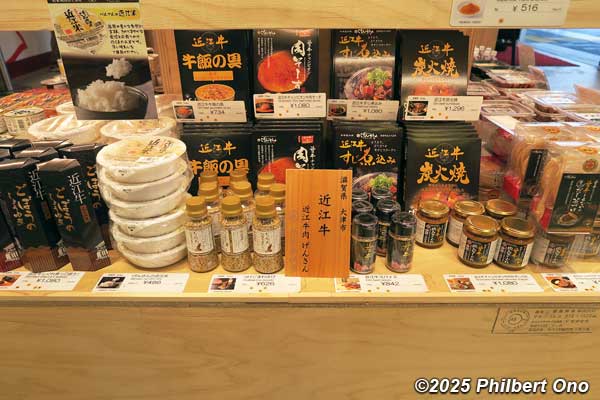
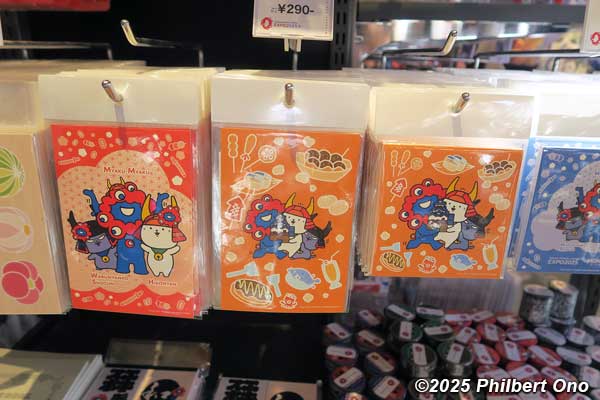
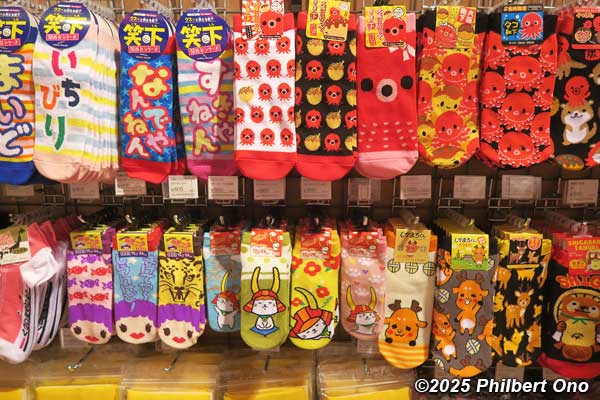
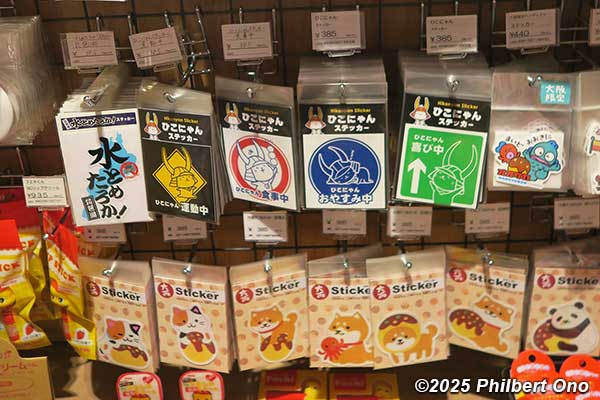
Supplemental: Tower of the Sun (Expo ’70 Park)
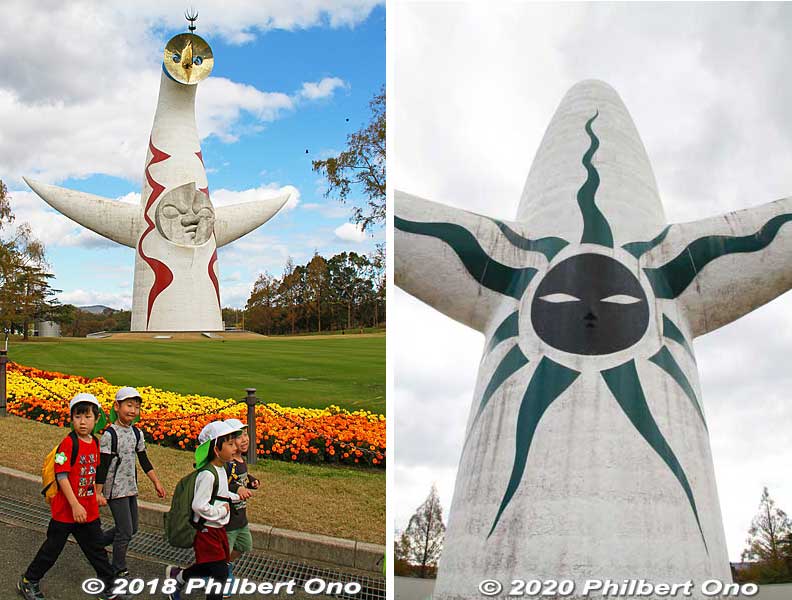
If you have time, I highly recommend also visiting Expo’70 Commemorative Park in Suita, an Osaka suburb. The park has the famous Tower of the Sun sculpture with three faces of the sun. It was the iconic symbol of Expo ’70 by mad genius artist Okamoto Taro.
On the top is a golden face representing the future. During Expo ’70 in the evenings, this face’s eyes emitted a blue beam across the expo site. Simply awesome.
The second face is on the tower’s front midsection, a sculptured, mashed face representing the present. This face is accented with red lightning bolts on both sides.
The third face is painted on the back of the Tower (right photo), representing the past as it looks back. This black sun face is painted on Shigaraki ceramic tiles. (See closeup photo.) Shigaraki ceramics have been a fixture at Osaka’s Expo ’70, Expo ’90, and the current Osaka Expo 2025.
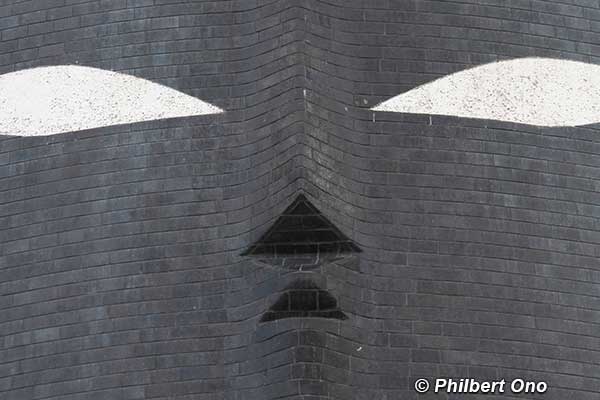
This magnificent edifice was originally intended to be temporary and was scheduled to be demolished after the expo. Fortunately, a successful petition to preserve it led to a decision in 1975 to preserve it permanently. It has since become another iconic symbol of Osaka and the most visible symbol and legacy of Expo ’70.
Osaka Expo 2025 Basic Info
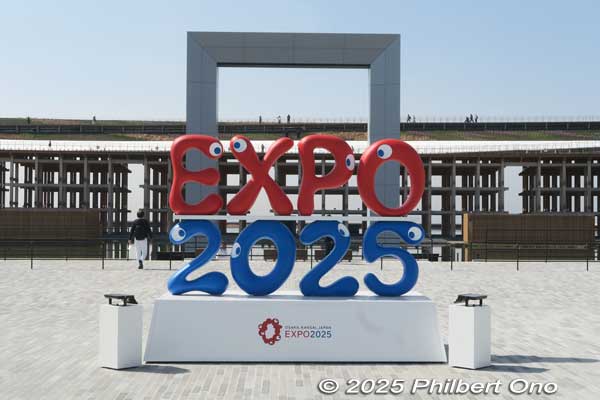
- Period: April 13th to Oct. 13th, 2025, open 9:00 am to 10:00 pm (pavilion entry may close by 8:00 pm).
- Location: Yumeshima island on the waterfront in the city of Osaka. Map: https://maps.app.goo.gl/zGqQgtyEbLigBZH28
- Getting there by subway: Take the Chuo Line (green) Osaka Metro subway to Yumeshima Station (夢洲駅) outside the East Gate of the expo site. Details here… Map: https://maps.app.goo.gl/6ycS1o5FcSD6FZhJ9
- Getting there by bus: Shuttle buses run from major train stations in Osaka and Sakurajima Station. Airport Limousine buses from Kansai Airport (KIX) and Osaka/Itami Airport (ITM) also go to the West Gate. Make reservations here…
- Area: 155 hectares (383 acres) (Three times larger than Universal Studios Japan in Osaka, bigger than Tokyo Disney Resort.)
- Pavilions: 150+ international pavilions (including about 60 standalone pavilions and 94 booths in shared halls) and 27 Japanese pavilions. (As of this writing, Nepal Pavilion remains closed due to incomplete construction.)
- Theme: Designing Future Society for Our Lives
- Official mascot: Myaku-Myaku
- Official website: https://www.expo2025.or.jp/en/
- Official expo maps (English): https://www.expo2025.or.jp/en/expo-map-index/map/
- Expo tickets: https://www.expo2025.or.jp/en/tickets-index/
- Official apps: https://www.expovisitors.expo2025.or.jp/service-support/about-related-app
- Official social media (only in Japanese, no visitor support): https://www.expo2025.or.jp/en/officialsns/
Also see:
